L. Andrew Cooper's Blog, page 6
May 15, 2024
Interview with Author J.V. Sadler: Licking
An emerging author with a strong sense of the unnerving and the uncanny, J.V. Sadler discusses her debut collection of short stories and poems, Licking.
LickingJ.V. Sadler’s first collection of short stories tiptoes through the waking and unconscious worlds. Take a peek into the upside-down world of Licking. Transcending reality, these stories integrate a diabolical twist into the mundane. In the title story, a couple’s hopes for a baby turn sour; “The Baboon” is a story of self-deprecation gone wrong; in “Unafraid” a woman will do anything to overcome her fears; eavesdrop on a dysfunctional family in “Family: Dinner;” a crowd struggles to save a dying woman in “Almost;” and many more twisty stories will have you questioning the everyday hustle and bustle.
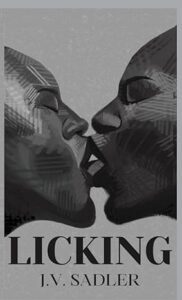 Click the pic for more on Amazon!The Interview
Click the pic for more on Amazon!The Interview1. The Nightmare-scape. In your introduction to Licking, you write that you use your nightmares as the basis for much of your work. What is your process for transforming dream into fiction? You also describe your nightmarish work as different from a lot of horror fare—other than foregoing the usual boogeymen, what elements, particularly stylistic elements, set it apart? You mention that your work leans, at times, toward the surreal. What are examples of surreal moments that you can share without spoilers?
JVS: To turn my dreams into fiction, I must first journal about my dreams. I write dreams that interest me down on paper and try to decipher if there is a more profound meaning to them. I usually have the key scene from the dream and write around that scene. For example, for “The Decrepit Ones,” I had one key scene in a bathroom and had to figure out how to start and end it.
Licking, while leaning into surrealism, also seems to dabble in magical realism. The stories are set in the mundane world but then are invaded by horrific elements. I ask readers to forego the boundaries of logic and lean into the freedom of possibility. With just minor tweaks in the physics of the real world, these stories could happen. I believe this is what sets Licking apart from other horror—criss-crossing between the imaginary and the real.
Much of my writing is inspired by the Surrealist and Dadaist movements. Some moments in Licking that dip into surrealism include the struggles of Jaina in “Yappy.” Due to an unfortunate condition, she can no longer stand up for herself, which puts her in miserable situations. Or the nightmarish museum under strict rule in “The Decrepit Ones” has visitors’ own universe superseding the expectations of what a “regular” school field trip should be like. These stories have readers questioning, “Is this really happening? Or is it all a dream?”
2. Licking and Ingestion 1. In Licking, both the poetry and prose, licking, tasting, and consuming people can be a horrific act of revenge, but it can also be intimate, erotic, perhaps even transformative. How would you define “licking?” Does the act change meanings from poem to poem, story to story, or does it have an overarching significance? Why do you portray the consumption of others, literal or figurative, with such intimacy?
JVS: “Licking” is a perversion, a violation, a crossing of boundaries… I intentionally wanted readers to feel the same dirtiness, ickiness, and wrongness I had when dreaming of some of these stories. In Licking, not only are the characters experiencing being “licked,” but the reader is as well. The collection is a sensory experience like stepping in liquid with socks on or having sticky hands without knowing the origin of the substance.
3. Entrapment 1. In “The Decrepit Ones” and “Family: Dinner,” you portray disenfranchised characters facing institutions (in the former, literally a museum, and in the latter, the patriarchal family) that ensnare them, institutions with horrors they must fight against lest they be consumed. In the former, the institution seems to be powered by white privilege and aggression, and in the latter, the institution seems to be powered by male privilege and aggression. Do your stories offer a conscious, systematic critique of institutionalized injustice? If so, what makes horror stories useful for such critique? If not, how do you think such critique sneaks in?
JVS: What is more horrific than real, systematic, institutionalized injustice? What’s more horrific than colonization? Genocide? Cultural erasure? I believe horror is the perfect medium to showcase injustice. Because the stories in Licking are so open-ended and “up for discussion,” these critiques do sneak in. In the other stories, the injustices may not be as pronounced as in, say, “The Decrepit Ones,” but they still offer a deeper analysis of present society.
4. Facing Fears. In “The Baboon” and “Unafraid,” the act of facing one’s fears seems to me to be both triumphant and tragic. Do you agree that it’s both? If so, why does standing up to bullies (in the former) or actively conquering phobias (in the latter) slide toward negative extremes? Do you think a woman finding strength also risks losing her place within humanity?
JVS: To face one’s fears is to finally experience freedom but simultaneously to escape the safety that fear has to offer. There is a safety in keeping the unknown unknown. There is a safety in looking at the world through a fearful lens so that one is never disappointed, taken by surprise, or bruised. When you let go of fear, you are also susceptible to all that I’ve mentioned. There is a saying along the lines of “Do what’s right even if it’s not easy.” In these two stories, both characters achieve liberation even if it means facing those negative extremes.
I think a woman finding strength is an act of rebirth. But births are catastrophic. There’s blood, pain, and crying during a typical labor. It’s quite poetic, isn’t it? Finding strength isn’t some cutesy frolic through daisies, it’s a dirty trudge through garbage to get to the other side, which is personal liberation. A woman loses her/their place in humanity in that “the place” is held for those who conform. “The place” is held for a woman who loses themselves in trying to fit that definition of what a woman should be. To break that norm is to openly reject that place and say “I choose my own place” even if it means disaster. A fearless woman is, seemingly, a wonderfully disastrous thing. I love it!
5. Phoning Fears. “Almost” and “Yappy” involve horrors that unfold—in the former, with some dark humor—at least in part due to people’s infatuations with their phones. Is technology more a source or a catalyst for the horror in these stories? “Yappy” is particularly disturbing as the narrator is “reduced” through her phone-related experiences. Is her reduction victimization, or does she willingly surrender parts of herself through technology?
JVS: Having grown up in the digital age, I’m not one to knock all technology as some dark source for human destruction. But I do, however, warn that it’s not the technology itself but the way that it is used. In both stories, the technology can be used for good. For example, the phone can be used to save a dying woman in “Almost,” and in “Yappy,” it can be used to find love and romance. Instead, technology is abused by abusers—clueless onlookers and online predators.
6. Licking and Ingestion 2. The collection refers several times to the darkness inside people getting out, licking, and consuming them. What is this darkness, and where does it come from? Ought we to let it out? Are our relationships with ourselves nightmarish? Empowering? Erotic? All of these? None of these? Why or why not?
JVS: The darkness that I refer to is the shadow side we each have in us: those dark thoughts, those sad moments, the not-so-perfect parts of ourselves. We should let it out. Yes! But transmute such shadowness into something beautiful. For me, I let out my darkness in my writing. All of my sadness, strangeness, grief, anger, sorrow, et cetera I let out in a productive and non-harmful way through writing. I hear of these rage rooms where you pay to destroy things. I am a supporter of such rooms because they are a way to release heavy emotions without harming ourselves or others. We should be allowed to scream in the void sometimes.
The relationship we have with ourselves is a combination of a lot of things. We are whole beings with a range of emotions both light and dark, good and bad, dream-filled and nightmare-fueled. It becomes dangerous when we try to ignore the darkness because then it slowly but surely takes us over. Then, it takes charge. Lastly, it uncages itself in unsafe ways.
I like to call myself a darkness connoisseur, an academic of the darkness… I want to sit down and have a conversation with the devil itself so that I may better know it.
7. Entrapment 2. “Trapped, Chained” also features characters trapped in a very bad situation, characters forced to wonder, “What were they to do without their captor?” And their captor is “a typical Caucasian man, perhaps making him most dangerous” when compared to “a psychopath [or] a sociopath.” This story seems to say something about a socioeconomic system that creates a racial hierarchy that subjugates people while making them radically dependent on their oppressors… but I may be off the mark. What are you saying about relationships between captors and captives, and how does what you’re saying specifically reflect on the history of race in America?
JVS: That particular line about the “typical Caucasian man” has been a topic of much conversation. It’s become quite controversial. I want people instead to consider the line that comes after it: “He weaves through society without anyone ever doubting his character, his actions, his mind.” In our present-day society, the minds of marginalized folks, especially Black folks, are heavily scrutinized whether it’s society believing we are less intelligent or less sane. This scrutinization has even seeped into the medical field via historical and present-day malpractice and cruel human experimentation. On the flip side, those who have the privilege of writing history write themselves as the prime exemplars of the human: the better psyche, the better intelligence, and the less prone to be doubted.
Let’s take the zipping of a purse or the locking of a car door, for example. We’ve seen this trope countless times. Let a typical Black man walk past a purse-holding civilian or an unlocked car. That purse will be zipped and the car door locked. Let a “typical Caucasian man” do the same, and those cautions are usually not taken. In other words, his character, actions, and mind are not questioned in the same way that marginalized people’s are. This is why Ted Bundy could be called handsome and charismatic but Tamir Rice, a gun-weilding killer.
With “Trapped, Chained” I wanted to portray a sort-of reversed Stockholm Syndrome where the captor sympathizes with his victim and does not have the same apathy of the typical portrayal of a kidnapper or serial killer. As a person with mental illness—specifically bipolar disorder—it’s disheartening to see the sole depiction of a killer be that of someone with a mental illness. I thought to myself, what if he was perfectly sane but for some reason got a kick out of kidnapping while at the same time disappointed in himself and empathetic toward his victims? I want to explore this further in my future writings.
8. Licking, Last Words. The penultimate tale in Licking is “Licking,” in which the darkness inside mentioned in other pieces threatens to take the form of a baby, bringing back the darkness of family from “Family: Dinner.” Do you think the book locates something horrific within the family and, more specifically, reproduction? If so, what is it? If not, why does so much darkness seem to gather around familial ties? And as for ties—the final piece in the book, “I Licked You,” seems to be a farewell to the reader. The title has at least two meanings. What do you think this farewell says about the relationship your book establishes with its reader? What should your reader expect from the experience of getting licked?
JVS: There certainly is darkness concerning familial ties. In our present-day Western society, we seem to put more emphasis on the biological, nuclear family unit than on the created or found family. The nuclear family replaced the concept of the village and replaced what was a community with a heteronormative father and mother. The nuclear family is a Eurocentric concept that overrode those of specifically Indigenous American and Indigenous African communal societies. The loss of such a support system, I believe, is very sinister. It places the burdens of raising and rearing a child on the hands of two individuals rather than a whole community. In both stories, the families could have had a better outcome if surrounded by community rather than just a single-family unit.
The end piece, “I Licked You,” is one of my favorite pieces. I love fourth-wall breaks, but this fourth-wall break is a sensory break as well. “I Licked You” is the end of an experience which is the “Licking.” The book establishes an intimate relationship with the reader. Yes, it is erotic, it is dark, it is off-putting, but I hope it will be, at least cautiously, welcomed. I want the reader to sit down after being “licked” and take time to think. How did you feel? Did you just read the words, or did you experience the words? I want the reader to be able to sit with their own darkness for a while and wave to it.
9. Access! How can readers learn more about you and your works (please provide any links you want to share)?
JVS: I have a linktree (https://linktr.ee/jvsadler) where you can find all the links to my book, my website, and other interviews! You can buy Licking in paperback, audiobook, and e-book on Amazon (https://www.amazon.com/dp/B0CSWPVWNZ)
About the Author
J.V. Sadler is a Cincinnati native, writer, and poet. Sadler specializes in speculative fiction, horror, sci-fi, dark fiction, and surrealism.
The post Interview with Author J.V. Sadler: Licking appeared first on L. Andrew Cooper's Horrific Scribblings.
May 1, 2024
Interview with Author Aron Beauregard: Through the Eyes of Desperation, The Red Version
Two-time winner of the Splatterpunk Award Aron Beauregard shares insights about his recent book Through the Eyes of Desperation, The Red Version and teases us a bit about dark treats to come.
Through the Eyes of Desperation, The Red Version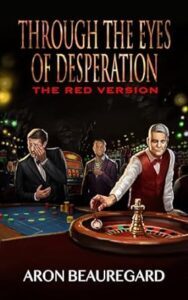 Click the pic for more on Amazon!
Click the pic for more on Amazon!ALL BETS ARE OFF
Red has tried to keep his nose clean, but the sins of his past still haunt him. They’ve forced him back into the darkness—toward a life he’d hoped to leave behind. Now he has just four days to make things right.
The scam seemed safe enough at first, but now Red is six figures in debt, and there’s more than just money at stake. There’s making things right with the daughter he turned his back on. There’s greasing the palms of the disturbed criminals holding his geriatric mother as collateral. There’s being able to face himself in the mirror.
Everyone in the city’s underbelly knows there’s only one way to obtain such a large sum on short notice…
Shadows is an underground casino where nightmares are born and dreams go to die. Where humiliation, drugs, and violence are as much a part of the games as cards and dice. When Red enters a world where money isn’t the most coveted prize, will he earn enough to solve his problems, or suffer the ultimate loss?
This volume contains 17 interior illustrations.
WARNING: This book contains graphic content. Reader discretion is advised.
The Interview1. A Desperate Universe. Through the Eyes of Desperation, The Red Version has a companion novel, Through the Eyes of Desperation, The Black Version, by Daniel J. Volpe, as well as a related book that you and Volpe co-authored, Sew Sorry. How did this unusual collaboration come to be? What was your process? Should readers approach the different pieces of this universe in a particular order? If so, what is it, and if not, why not? Do you expect this universe to keep growing? Why or why not?
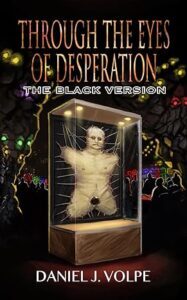
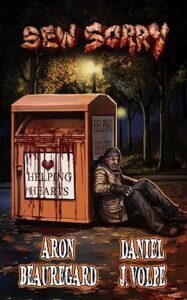
AB: The process was fun, but a lot of work. We went on a writer’s retreat in this cabin in upstate NY. Over the course of a few days, we fleshed out the story of Shadows casino as well as some of the characters inside, but it still took us nearly a year afterward to release the books. We had to edit each other’s books, expand, deduct, and then have another person edit both books before we were able to release them. It was truly an exhaustive process since the books have quite a bit of connective tissue. Despite being connected, all the books also serve as stand-alone works. You can read any single title and not touch any of the others, and you should get a satisfying read. But for the best reading experience, I do suggest checking them all out. There is no particular order in which they need to be read. Will the universe expand? Anything’s possible if enough people read and enjoy the stories!
2. A Criminal Universe. Some of your closing words refer to the “city of violence” in which your tale has taken place, and indeed, the major settings you use are mostly rundown buildings, dirty streets, and a casino splattered with gore, places populated with mobsters and junkies who seem to be in the clutches of a pandemic sociopathy. Are you reflecting on particular times or places? Shadows, the casino, is likened to Hell—have you created a hellscape or a world closer to, and critical of, our own? Your world’s seedy atmosphere evokes older pulp fiction and hints at noir—how do those traditions relate to your take on hardcore horror?
AB: I enjoy the pulp and noir times. Technology tends to ruin horror sometimes, in my humble opinion. Many of my books tend to take place in the 90s. With Through the Eyes of Desperation I wanted to build a city of violence, sort of like I did in my other Splatterpulp book Yellow. Not exactly the same, of course: each place has its own shades of sadness and degeneracy. But I enjoy having a nameless city in some of my stories. I think it’s far more interesting than reality.
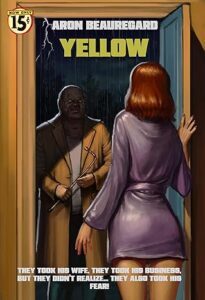
3. Money, Power, and Sadism. Speaking of seeing the world through critical eyes, at one point Red reflects, “If you have less, you are less—at least under this regime.” In the world of Shadows, anybody could get hacked to pieces, but you’re much more likely to meet a grisly fate if you don’t have money. To what extent, if at all, does this world of high-stakes gambling reflect on investment capitalism? I’ve branded a lot of your characters as sociopaths: many are sadists as well. Is a regime under which having less makes you less a sadistic regime? Why or why not?
AB: It’s more just a simple statement about how many people—but not all—in the world view self-worth. One’s importance, success, and overall impact is heavily tied to finance. In the world of Shadows, one of the regime’s founding principles was to allow those without such backing to have a chance at changing their lives. But such a chance comes with the greatest risk of all.
4. Anxiety and Desperation. What Red suffers through in this novel is enough to make anybody anxious (to say the least), but from the beginning, his perspective calls attention to his anxiety as if it might be out of the ordinary. Do you think the novel suggests Red has an anxiety disorder or other underlying condition that propels him psychologically, or are his reactions to situations generally proportionate to how fucked up they are? How would you describe Red’s psychological make-up? He’s motivated by his daughter, his mother, being able to face himself… but, bottom line, what really drives his behavior?
AB: I wasn’t really imagining him having any kind of disorder. Red’s just kind of rolling with the circumstances of his life and doing his best to tread water. Without giving too much away, I think he’s probably driven mostly by guilt.
5. Addiction and Other Pastimes. Red knows himself well enough to know that at one point he gave up a heroin addiction for a gambling addiction, and his addictions—as well as other characters’ addictions in the novel—tend to get him into a lot of trouble. At the same time, the availability of hard drugs inside Shadows appears sometimes to be a blessing. What position or positions, critical or otherwise, does your novel take on gambling and other addictions? The next time I go to Vegas, I will undoubtedly think about your book and feel a little queasy. Do you mean to associate more mundane casinos and recreational substance use with extreme horrors? Why or why not?
AB: When I write books, most of the time I’m not trying to take a position, I’m just trying to tell a story. I think that’s where some writers get it wrong, and the work can come off as preachy. Does gambling—or any addiction for that matter—have its pitfalls? Of course. But there’s a big difference between five guys getting together and playing a friendly game for a $100 pot and the guy drinking by himself who spends every paycheck at the tables. For some folks gambling is fine; for others, it unravels their entire lives. It was the latter for Red.
6. Escalation and Desensitization. While escalating violence and gore are features of much hardcore horror, Through the Eyes of Desperation, especially in later chapters, uses locations like levels in a video game (or layers of Hell), each at least threatening something ghastlier than the last. How conscious were you about making escalating violence a matter of structure, and did you think of video games or other similar types of storytelling? How difficult is one-upping your last gruesome scene? As Red advances, he thinks about the violence having less of an impact on him. Do you think his position reflects the reader’s? Why or why not?
AB: The three layers at the end are symbolic. Many of Red’s problems began after a three-game parlay, so it was only fitting. It is certainly difficult to build such depravity, but it’s also fun. I dive pretty deep into my imagination to conjure such things. This one didn’t have any video game inspiration, but my other book Playground did. I don’t think I’m prepared to paint all readers with one broad stroke. Each person is an individual and will have unique feeling about the impact.
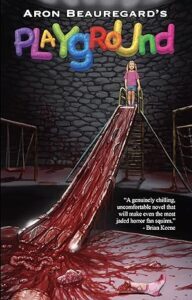
7. Luck, Chance, and Choice. Given that Shadows is a casino, I don’t think I’m spoiling anything by saying that a lot of gambling drives the plot. Themes related to luck, chance, and choice seem natural, and you develop them well. Does luck actually exist in this novel’s world? Why or why not? Are the chances ever fair? Choice might be the biggest issue: Red thinks more than once that he has come to the point where he is through no choice of his own. Does your novel stage a battle between free will and determinism, or the idea that outside forces determine what we do?
AB: These are all interesting and deep questions but, simply put, Red’s luck is kind of in the readers’ hands. Those who decide to read the book will understand once they get to the chapter titled “The Gamble.”
8. Human Experiments, Writing Experiments. One of the biggest questions driving your story seems to be, How far will a truly desperate person go? For example, how far will Red go to make things right with his daughter and save his mother from the consequences of his debt? Shadows seems like an experiment to test out the answers to that question, seeing how far, how very, very far, desperate people will go. Do you agree with this view of your novel as an exercise in human experimentation? Why or why not? On top of that, the novel, though highly readable, is a little experimental, jumping around in time in a way the increases escalating tension and ending with a formal coup I won’t reveal. Are you experimenting on your audience?
AB: I think I’m experimenting with my readers somewhat. In breaking the 4th wall for one since it’s the first time I’ve ever done that. But that won’t be where my experimentation stops. I have other ideas that are far stranger than this coming soon! But I truly hope the readers enjoyed this.
9. Future Visions? I try not to ask standard questions too often, but since you seem fairly prolific, I really am wondering—what can you tell us about works in development and in mind for the future?
AB: Please stay tuned! While I can’t reveal much at this moment, I will say that two of my most creative works are going to be released in 2024/2025. I wish I could give more detail, but I promise, when you hear about these projects, you’ll know exactly what I’m referring to.
10. Access! How can readers learn more about you and your works (please provide any links you want to share)?
AB:
Signed books: ABHorror.com
Audible: Audiobooks
Amazon: eBooks
Facebook: Aron Beauregard
Instagram: AronBeauregardHorror
Twitter: AronHorror
TikTok: @AronBeauregardHorror
Newsletter: Subscribe
About the Author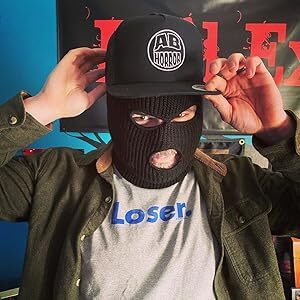
Aron Beauregard was born and raised in Central Falls, Rhode Island. He’s been writing horror since the 6th grade and has now released over 20 books. An avid supporter of horror art and illustration, Aron has made it his standard to hire illustrators for every book that he puts out himself under his brand AB Horror.
His writing is dark and without boundaries and, as a result, he’s won the Splatterpunk Award twice after garnering 4 total nominations.
To get the latest updates about upcoming releases, signed books and merchandise, film news, his horror podcasts, and so much more, visit his website:
To subscribe to his free newsletter, join the AB Horror Maggot Mailing List at:
https://aronbeauregard.substack.com
The post Interview with Author Aron Beauregard: Through the Eyes of Desperation, The Red Version appeared first on L. Andrew Cooper's Horrific Scribblings.
April 3, 2024
Interview with Author Jonathan Butcher: Something Very Wrong and Your Loved Ones Will Die First
Scary, funny, and delightfully twisted extreme horror writer Jonathan Butcher shares some thoughts on his Splatterpunk Award-nominated story collection Something Very Wrong and his forthcoming novella Your Loved Ones Will Die First.
Something Very Wrong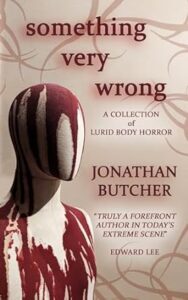 Click the pic for more on Amazon!
Click the pic for more on Amazon!Nobody is safe. No body is safe.
A gruesome fetish experiment…
A bloodless gorefest…
A beast of flesh and metal…
A sensuous parasite…
Endless skin-warping atrocities.
Read on. Give in to the inner voices, begging to reconfigure your meat and muscle. Because something here is very wrong.
From the author of the indie hit What Good Girls Do come nine gut-churning stories of anatomical horror, including three brand-new, never-before-published tales.
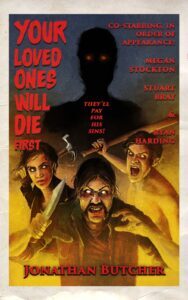 Click for a chance to get this forthcoming work early!
Click for a chance to get this forthcoming work early!They’ll pay for his sins.
Ethan Stone has everything: money, a beautiful wife, and a powerful family name. But during a shocking night of ritualistic violence, someone—or something—from his past wants to snatch away the people he loves. Will he learn the truth and end the massacre, or is there no escaping the past?
Your Loved Ones Will Die First is an extreme horror, a race-against-time thriller, and a supernatural mystery, bound together by torn flesh and not-so-innocent blood.
Interview1. Something Very British? In Something Very Wrong, at the beginning of the story “Family Recipe,” you contrast expectations of the American Deep South with the “real south,” Cornwall, and just in case the title “Beneath the Moor” isn’t enough, an early paragraph of that story specifies that a character is looking at the “British countryside.” Like Ed Lee with some of his uniquely American grotesquerie, to what extent do you see yourself crafting distinctly British horrors? Do you think Britishness is part of your brand? Why or why not? The transatlantic extreme horror movement owes so much to Clive Barker’s early work—how do you feel about the extreme scene in the U.K. now?
JB: While it’s fun to tell uniquely British stories, most of my readers come from the United States, so I’m not attempting to plant any flags – I’m just trying to write decent horror!
It’s important for any author to “write what they know,” but I’ve worked abroad, and I’m also married to an American, so I have influences that go beyond the U.K. In fact, all three of the longer works that I’m hoping to release this year take place in the U.S., so it’s lucky that I have an American wife who can point out any Britishisms that may sneak into the stories!
As for the British extreme scene, I’ve been happy to see names like J. Boote, D. E. McClusky, and Sean Hawker writing some brilliantly vile stories in the last couple of years and getting the recognition they deserve. I grew up reading Clive Barker, Graham Masterton, and James Herbert, so I am certainly a fan of British splatter.
2. Bodies Very Wrong. In the “Author’s Note” that launches your collection, you write of your love of body horror that goes back to your childhood viewing of The Thing (I’m assuming Carpenter’s 1982 version). The physical monstrosities of that film have been linked specifically to the (very early, not-yet-named) AIDS epidemic and virtually every kind of paranoia imaginable, Cold War and otherwise. Do you imagine something wrong metaphorically beneath the gruesome physical transformations your stories depict? “Alternate Route,” for example, seems to have some philosophical implications about bodies and technology. What do you think that story—and any others you care to comment on—has to say about relationships between bodies and the world?
JB: The horror genre is ripe for social commentary and philosophical exploration, and body horror offers some great opportunities for this. However, with almost every tale in that collection, I have a confession: I was writing purely for fun. “Alternate Route” is perhaps the exception to this, because the concept of A.I. has become impossible to ignore. I’d had an idea I wanted to write for a long time, about a GPS that goes rogue and decides to change a driver’s journey to one of its own malicious choosing. With the rise of ChatGPT and the like, I found a way to take the concept further and explore (in a very light-touch, splattery way) how a computer’s moral thinking might differ from our own.
I always try to write beyond what’s become the typical “Here’s an evil man doing evil things, isn’t he gross?” kind-of tales, but regarding body horror, I just think it allows for a more direct path to horrifying a reader: if the horror is inside the human body, then there really is no escape.
3. Like Us. “A Threesome with Caricia” might be the most twisted tale in the volume, and since I don’t want to give away the twisted twists, I’ll just mention that, as protagonist Stephen gets drawn into the titular threesome by Caricia’s sister Natalya, Natalya explains he’s right for them, saying, “Because you’re different. You’re like us.” This attempt to bond brings to mind the “one of us” mentality of the freaks in Tod Browning’s film Freaks (1932), early cinematic body horror. To what extent is body horror putting a spotlight on what’s physically different, perhaps unbearably, unimaginably so? Do you think body horror involves more attraction to or repulsion from the physically outré? Why?
JB: I think that a reader’s response to body horror depends more on their preferences than the content itself. For me, there is pleasure to be found in disgust, and I have an attraction to atrocity. I’ve never really been able to pin down what it is about body horror I love so much, because if I did, I’d end up sounding like some bio-nihilist who wants the human body to explode, grow new limbs, and melt…
As for your question about whether it puts a spotlight on physical differences, for me personally the joy of body horror is in the transformations people make into otherworldly, distorted new forms, rather than the perceived horrors of being different. I just want to see some new human shapes and rearrangements…
4. Genital Bookends. Something Very Wrong begins with “Drilldo” and ends with “Last Night’s Gig,” both of which involve genital… if not mutilation, at least extreme distension, and it serves up some nice genital horror right in the middle, too, with “Dripping Wet.” It’s all properly disgusting, but perhaps because, as Monica J. O’Rourke informed me, I’m a sicko, I also find it… pretty darned funny. What’s the attraction of writing about genital catastrophe? What makes these stories work? Finally, assuming I’m not the only sicko involved in this operation, why do you think the genital zone of body horror can play so readily for laughs?
There’s a level of childish play involved in extreme horror and body horror, and for some reason, there’s still plenty of taboo involved in our “downstairs areas.” Unless I’m writing something more serious like my “Elizabeth” books (What Good Girls/Men Do), any genital destruction I write about tends to have some humour involved. I don’t often build a story around a scene of penile or vaginal gore, but if it happens to fit, then so be it! The human body is an amazing thing, but our preferential attitudes towards different parts of it verge on the ridiculous, so I’m all about equality: I’m just as happy to demolish an arm as I am an anus.
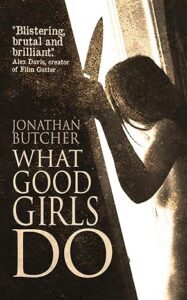
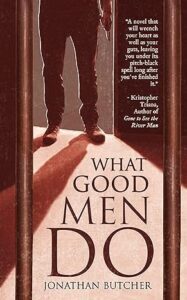
5. Morality Play. Many stories in Something Very Wrong revolve around characters guilty of various transgressions, often sexual transgressions such as infidelity. Are the horrors that visit them punishments for their transgressions? In “ChaGrin,” you even play with the idea of psychomachia (physical manifestations of good and evil providing the protagonist with advice), though in a novel and grotesque way. What inspired this representation of “moral” reasoning? Does a moral sensibility lurk behind your tales more generally? If so, how would you describe it? If not, is it fair to say that morality itself edges into the absurd? Why or why not?
JB: I find human ethical conflict intriguing, but I don’t really believe in the concepts of good and evil, and metaphysics in general disinterest me. The worst part of human nature is the selfish urge that disregards consequences for others, so I think that as a horror author it’s my duty to explore characters’ thought processes whenever they consider doing something transgressive. Even the worst serial killers have limits – for example, the necrophile serial killer Ted Bundy would never discuss the child he killed – so I think that considering morals and regret can make for a compelling read in horror stories. I don’t think that I write typically moral tales, but at the same time, I’m not a nihilist, so if I take a certain amount of pleasure in ruining a heartless scumbag or two, so be it. However, I believe that we live in a state of chaos and that life and death have no concern for the individual, so readers should never expect a happy ending from me. If they get one, it’s just their lucky day.
6. Immorality Pays. For your forthcoming novella Your Loved Ones Will Die First, the description begins, “They’ll pay for his sins,” so the previous question continues to be relevant. Is the someone or something from Ethan Stone’s past somehow righteous? Does shedding “not-so-innocent blood” make the shedding more acceptable? From an artist’s and/or reader’s perspective—more enjoyable?
JB: I’m not going to discuss the details of whatever my main character may or may not have done – that’s a big part of the storyline! I think that the average extreme horror fan is fine with any kind of blood being spilled, as long as it’s done in a wild, creative way. I prefer characters to have more personal motives, so while they may be convinced that what they’re doing is somehow “righteous,” that doesn’t necessarily mean that I agree. As I mentioned before, there aren’t many real-life people or fictional characters who think that they are the villain – the ghastliest abusive slaughterers can often still justify what they’re doing, at least in their own heads.
7. First Class. Something Very Wrong falls into the body horror niche of extreme horror, but Your Loved Ones Will Die First seems like it belongs somewhere else on the extreme spectrum. How would you classify it, and why? What are some examples of extremes that readers can look forward to? To which of your other works does it best compare?
JB: There are definitely scenes of body horror in this story, but my main aim was to produce a fast-moving tale that allowed my guest authors to contribute a scene of devastating gore. It’s part thriller, part horror, and all extreme, and having three other brilliant authors – Megan Stockton, Ryan Harding, and Stuart Bray – along for the ride really made it a fun project to work on. Each of them was given an important character to dispatch, and each of them did so with gusto. I’d say that it has the pace of What Good Girls Do, the crazy set-pieces and flashbacks of Chocolateman (but without the poop), and a demented twist all of its own.
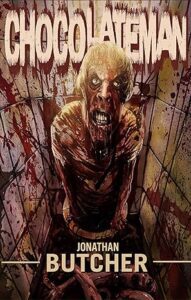
8. Supernatural Returns. Your Loved Ones Will Die First includes “supernatural mystery” as part of its recipe. Past crimes haunting the present—and/or the return of the repressed—have been a staple of Gothic/horror fiction since its inception, so you’re drawing from a deep well. What were this story’s specific influences, especially the supernatural dimensions? How does this story blend the supernatural with what people take to be natural or “real?”
JB: Writing something with supernatural elements for a splatterpunk/extreme horror audience can be a tricky task, because quite often these books are set firmly within the real world. The main influence for this story is going to sound incredibly arrogant: it was my own work, which I tried to write when I was 17, but which I was not yet a good enough writer to finish. However, the central paranormal idea has always stuck with me, and I’m glad it’s now become a book (and, depending on its success, who knows? Perhaps a series). So the supernatural stuff has nothing to do with demons, werewolves, vampires, etc – it’s mainly just a vehicle for me and my guests to use to write some eerie and ultraviolent scenes.
As for the precise nature of that idea, I’ll leave that for my readers to find out when they open the book.
9. Access! How can readers learn more about you and your works (please provide any links you want to share)?
JB: I’m on Facebook most often, but I’m getting better at posting to TikTok (@drbutchermd), and my writing is available in all formats on Amazon and godless.com.
I’m running an Indiegogo crowdfunding campaign to support the publication of Your Loved Ones Will Die First and offering some very nice perks. Please have a look: https://www.indiegogo.com/projects/your-loved-ones-will-die-first#/ The campaign ends April 16th, and anyone who pledges will receive their book a FULL MONTH before it is available on Amazon. The top tier perks have already been snapped up, but there are still signed limited hardbacks, signed paperbacks, and e-books available.
About the Author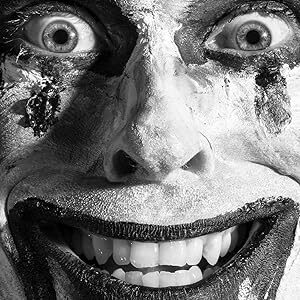
Jonathan Butcher is a Splatterpunk Award-nominated author who lives beside the ocean in Southwest England with his wife and fellow horror author Michelle von Eschen (pen name). He is best known for his transgressive extreme horror novella What Good Girls Do, but he has written three other novels, a horror collection, and numerous short stories/novelettes, and intends to publish three new books this year. In his spare time, he enjoys hiking and drinking fine beer and wine with his wife and friends, and living a life of horror through movies, video games, books, and his own hideous tales. He writes about the things that frighten, unsettle, disgust, amuse, or disappoint him, and he has a Master of Studies in Crime and Thriller Writing from the University of Cambridge. He can’t imagine a life without writing.
The post Interview with Author Jonathan Butcher: Something Very Wrong and Your Loved Ones Will Die First appeared first on L. Andrew Cooper's Horrific Scribblings.
March 27, 2024
Interview with Author Cassandra O’Sullivan Sachar: Darkness There but Something More, Keeper of Corpses and Other Dark Tales, and No More Haunted Dolls
Superb writer and English professor with a penchant for horror Cassandra O’Sullivan Sachar discusses her new novel Darkness There but Something More as well as her forthcoming collection of short stories Keeper of Corpses and Other Dark Tales and her edited volume of horror scholarship No More Haunted Dolls.
Darkness There but Something More: A NovelAfter the loss of her baby and subsequent divorce, Edgar Allan Poe scholar Marissa Owens leaves her tenured job as an English professor for a fresh start at her alma mater, Blackthorn University. As she begins to feel like herself again, one of her favorite students goes missing.
Then, the police find the body.
The investigation descends upon the campus, and familiar clues begin to surface. This triggers a disturbing memory from Marissa’s own dark past at Blackthorn—one she has attempted to keep buried.
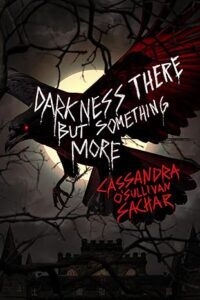 Click the pic for more on Amazon!
Keeper of Corpses and Other Dark Tales
Click the pic for more on Amazon!
Keeper of Corpses and Other Dark Tales
Life runs amuck in Blackthorn, Pennsylvania, and residents are rarely safe from the hands—or claws—of nefarious forces. From accidents to cursed objects, trouble is always afoot.
A woman prepares the bodies of nursing home residents for the funeral home while plotting revenge on her son’s killer. A college student has visions of people’s futures, but no one heeds her warnings. On a trip to Chile, a couple receives a personal wine tour for a price they weren’t expecting to pay: their lives. During her honeymoon to Greece, a newlywed discovers she hasn’t fully escaped her abusive mother. A lawn care provider thinks he has a bad mosquito bite, but it is something far, far worse. After covering up his dog’s accidental killing of his neighbor’s cat, a computer programmer runs into larger problems to bury. Since he was expelled from high school for his behavior, a troublemaker transfers to an academy where classes take place during the night and the teachers are known for their bite. A psychology professor must revisit a mistake from early in her career. Two sisters and their husbands sign up for a zombie-themed 5K, looking for some fun, but they end up running for their lives! A man suspects his girlfriend’s cat is the reincarnation of her husband. And more! These tales run the gamut of the horror genre.
This is a multi-author work united by the common theme of critical analysis of the use of horror tropes in literature, film, and even video games. Tackling issues dealing with gender, race, sexuality, social class, religion, politics, disability, and more in horror, the authors are horror scholars hailing from varied backgrounds and areas of specialty. This book may be used as a resource for classes that study horror or simply as entertainment for horror fans; readers will consider diverse perspectives on the tropes themselves as well as their representation in specific works.
The Interview1. Darkness Who? Your bio (below) reveals a few details about your life as an English professor with a scholarly background in horror fiction, and the protagonist of Darkness There but Something More, Marissa,is… similar. The similarity seems to invite (auto)biographical interpretation… but clever authors are often playful with such invitations, and you are a clever author. As characters in your book know, readers wonder endlessly about Edgar Allan Poe’s life… do you want readers wondering about you if/when they perceive the biographical similarities? Why or why not? Avoiding spoilers, to what extent is the book based on your actual experiences?
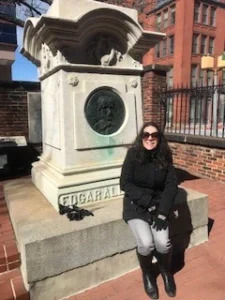 Sachar at Poe’s memorial grave in Baltimore
Sachar at Poe’s memorial grave in BaltimoreCOS: I know that people who know me will likely see some resemblances, but I wouldn’t want readers speculating about me since this is a work of fiction! Marissa shares certain characteristics with me beyond the career–for example, she is petite, enjoys Starbucks, and pledged a sorority in college, and I have drawn from my own experiences when conveying Marissa’s worries about her relationships with others and her fears of not fitting in. However, the events of the novel, thankfully, do not reflect my life in any meaningful way. What’s interesting to me is how diametrically opposed Marissa and I are in one particular aspect. While Marissa yearned for a baby and endured years of IVF struggles and miscarriages, I never planned to have children, but my unplanned pregnancy and ensuing motherhood in college changed my life trajectory. Somehow, though, when snippets of this story began to flood my mind, one of the first things I learned about Marissa was what she had lost and how it affected her. Another important distinction is our family backgrounds. I am fortunate to have grown up with love from parents who supported my goals, unlike Marissa. While I warned my mom that she was reading a work of fiction and that she needed to keep in mind that Marissa was not me, I wasn’t worried that she would think I was characterizing her or my dad since they are completely different from Marissa’s parents.
2. Darkness Where? Darkness There but Something More seems to fit in the tradition of what some, at least in academic circles, have called “Academic Gothic,” mostly referring to scholastic settings and Greek (or otherwise selective) society involvement but also netting creepy campus relationships. The tradition includes famous stories such as Algernon Blackwood’s “Secret Worship” (1908), films like Sorority Row (2009), and the TV show Scream Queens (2015). Were you reflecting on this tradition as you wrote your novel? How would you situate your book within it? What’s Gothic and/or scary about academic places and experiences, both in general and in your work specifically?
COS: As a lover of Academic Gothic, I wanted to provide readers with a feeling of eeriness through the references to Poe and an autumnal campus setting with its elderly buildings and buried secrets. Other works of this genre often depict elite, privileged characters, and I chose not to. Many of the students at Blackthorn University, like Marissa herself, are from lower socioeconomic backgrounds. Unlike the regal sorority mansion depicted in Scream Queens, Marissa pledged in a derelict rowhome, and I think this adds a different flavor to my novel, along with an element of grittiness. Despite the difference in glamour, the girls are just as willing to endure whatever it takes to become part of the sisterhood, and this can be extremely dangerous. It’s frightening to think about this underground side of college life, the brutal hazing continuing to take place in basements despite universities’ best intentions. While the dark academia aesthetic often focuses on dusty libraries and dimly lit stairwells, which can be intriguing and even romantic, my personal interpretation includes these harsher, uglier elements as well.
3. Return to the Repressed. Since the description of your novel mentions Marissa’s “dark past at Blackthorn,” readers might guess that going back there for a “fresh start” isn’t as bright an idea as, perhaps, going somewhere fresher than a place where Marissa doesn’t have a dark past. Nevertheless, characters in horror stories often seem to return to places perhaps better left in the past. What about Marissa’s psychology—consciously and unconsciously—justifies her decision to return? Fleeing tremendous grief and landing in more, Marissa is certainly traumatized. How do you represent the evolution of her mental state?
COS: Despite physically leaving Blackthorn as a young woman, Marissa never truly left it in the past. I believe she’s carried her guilt and has used it as justification for her unhappiness and misfortune. On the surface, Marissa returns to Blackthorn as an escape from the losses of her baby and marriage. When Candace, her friend and former professor, encourages her to apply for a position, it seems like a way to move on. It’s a convenient move to make since her connection to Candace is one of her only surviving relationships, so there’s familiarity and comfort at Blackthorn despite what happened in her youth. I believe Marissa understands on some level that she has unfinished business at Blackthorn and that she must finally face what happened there. The title of the novel, an obvious reference to Poe’s “The Raven,” signals that there’s more for Marissa in store than the darkness that has shrouded her.
4. Categories I. Since we both write horror and write about horror, I hope we share an interest in the meanings of genre (and marketing) classifications. Once again looking at your bio (below), I see Darkness There but Something More classified as “dark suspense” while the story collection Keeper of Corpses and Other Dark Tales is “horror.” What is dark suspense, and how does it differ from horror? Does the difference have anything to do with the old distinction between “female” or terror-based Gothic and “male” or horror-based Gothic? I recently interviewed a filmmaker, Rakefet Abergel, whose short film “Still” is about a miscarriage, a distinctly female horror (at least in the film) but a horror all the same. Do you think your novel of dark suspense deals in distinctly female terrors and/or horrors? Why or why not?
COS: To me, “dark suspense” suggests a mystery with horror elements, while “horror” focuses more on instilling fear, often through gruesome descriptions. I don’t know how much gender comes into the distinction, but I will say that Darkness There but Something More feels far more woman-centric in nature than my short story collection due to the focus on sisterhood as well as on pregnancy. While a fraternity could easily be substituted for the sorority, pregnancy through a male gaze is far different. I think that some of what Marissa endures–for example, heartbreak, betrayal, and imposter syndrome–transcend gender and are simply universal human experiences to which readers will be able to relate.
5. Categories II. Keeper of Corpses and Other Dark Tales is not only horror, but it “run[s] the gamut of the horror genre.” Since the gamut of horror has grown very wide over the centuries, I must admit I have trouble imagining a single collection making that run. What’s really involved in your run (feel free to show off your stories’ diversity with examples)? Was demonstrating the genre’s diversity one of your goals? If so, why? If not, how did the collection end up being so diverse? How do you expect readers to respond to the variety of tales? Which tale is most difficult to classify? Why?
COS: There are certainly sub-genres absent from my collection, but it covers a lot of territory: cursed objects, vengeful killers, zombies, ghosts, and more. From my own take on classic tropes (“A Gift for Avery” with a haunted doll) to horror comedy (“I’ll Sleep Tomorrow” with an overworked professor who ends up sacrificing far too much to achieve tenure) and even body horror (“Itch” with a guy who has a condition far worse than a mosquito bite), my hope is that there’s something for every horror lover.
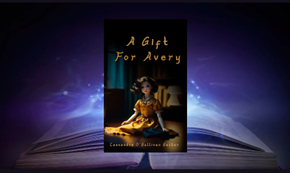 “A Gift for Avery” at PsychoToxin
“A Gift for Avery” at PsychoToxinI didn’t set out to cover any specific ground when I started writing short horror fiction, especially since I wrote the initial version of one story as an assignment in seventh grade, but I ended up with 27 tales, so it’s natural that they aren’t all alike. I wrote some for specific submission calls and others simply because I had a fun idea and wanted to try it. What I love about writing and reading short stories is the short-term commitment and how I can explore different characters and settings in a low-risk scenario. For example, I don’t know that I’d want to dwell in a world where zombies exist for an extended time, or that I’d have the endurance to extend the suspension of disbelief, but I had a lot of fun with my 3,800-word story “Run!”
Out of everything, the story that’s hardest to classify and almost wasn’t included due to its tenuous inclusion within horror is “Not a Cat Guy.” Jason is convinced his girlfriend’s cat is the reincarnation of her dead husband. Written in second person, it’s not scary and is more comic in nature, with the narrator coming across as rather buffoonish. But that’s something I hope readers will enjoy about this collection–the comic relief breaking up some of the darker, more sinister tales.
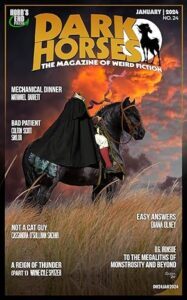 “Not a Cat Guy” in Dark Horses magazine
“Not a Cat Guy” in Dark Horses magazine6. “Pet lover and…” A line from your Amazon bio missing from the bio here identifies you as a pet lover. At least two stories in your collection, however, put animals at the center of the horror. What inspires you to include animals in your horrific scenarios? How do you think other pet lovers will react to these stories (violence involving animals is on a lot of people’s “trigger” lists)?
COS: I’ve had pets for almost my whole life, so it’s very natural for me to include them in my writing, whether horror or not. As a writer, I’d always rather kill off a human than an animal since it upsets me as a reader, especially when a killer is threatening their intended victim by taking the life of their beloved pet. I haven’t been able to entirely avoid animal deaths, though, in my own writing. Two stories in my collection involve the deaths of cats, but neither one dies at the hands of a human, and both deaths occur off-page. Even my depraved killers draw the line and stick to killing people. Unlike my character Jason, I am very much a cat person, so I hope I have handled the deaths with respect.
7. “… world traveler.” That’s the rest of the aforementioned line from your Amazon bio. Characters in your stories travel to Chile and Greece, and horrors either find them or follow them. As you know, early Gothic horror and travel narratives are closely related (even Poe’s only novel is a kind of travel narrative). How does travel affect the characters in your stories? Assuming readers aren’t actually from the locales you describe, how do you think the unfamiliar (or at least less familiar) settings affect their relationships with the characters and with the stories more generally? Brief examples from your tales are most welcome!
COS: During the semester, I’m so busy with the demands of my job (especially grading papers since I teach all writing classes) that I rarely even venture out of town. Therefore, after I’ve submitted my grades every semester, I’m ready for an adventure! My husband and I have learned how to snag great flight deals and travel on a budget, and we love exploring different landscapes and cultures. I think of my short stories almost as love letters (yet with horror twists, simply because I love writing horror) to the places I’ve visited. I hope readers enjoy traversing these unfamiliar territories with my characters, who are generally enjoying their trips until the horror finds them. Not everyone is able to travel to a Chilean winery, which is why I’ve researched the history of winemaking in the region and described the beautiful countryside in “Budget Wine Tour.” As much as my own real-life travels have impacted my writing, verisimilitude is paramount to me, so I always end up taking great pains to include details that will give the reader a realistic window into a new locale. By including true-to-life details, I am attempting to draw the reader into a suspension of disbelief that will better prepare them for the more fantastical parts of the story.
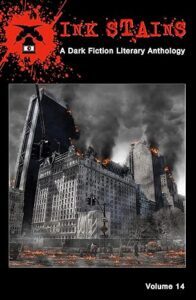 You can also find “Budget Wine Tour” in the Ink Stains anthology
You can also find “Budget Wine Tour” in the Ink Stains anthology8. Transcendent Horror. The non-fiction book No More Haunted Dolls: Horror Fiction that Transcends the Tropes that you’ve edited promises to be a horror resource that covers a lot of ground. What are examples of the major tropes the book examines, tropes that appear across literature, film, and video games? What works stand out for their uses of these tropes? Why? Is the horror genre even recognizable without its tropes? How does a work of horror transcend tropes? Can you provide one or two examples of trope-transcending horror?
COS: Some of the many tropes the scholars explore in the volume include the masked killer, cannibalism, vampirism, and possession. Two of the most heavily-referenced films are the Scream and Halloween franchises, while Dracula and Frankenstein stand out for books. While very different from each other, all of these works are beloved due to the iconic and often multifaceted nature of the villains and/or final girls.
I believe that tropes are necessary in horror; just as we need a relationship to focus on in a romance, there are expectations that must be met to fit the genre. I personally love horror tropes–give me a creepy, possibly evil child or a butt-kicking final girl any day. What I dislike is when a writer has nothing new to offer and the trope is the whole story. I’m always looking for fresh interpretations of a trope rather than a storyline that merely recycles what has been done countless times before. Writers can transcend tropes through layering elements that are fresh and unexpected.
A great example of a work that transcends tropes is Silvia Moreno-Garcia’s Mexican Gothic. The author takes the crumbling mansion trope and adds something new by placing the setting in Mexico rather than Europe or America. Additionally, she tackles issues dealing with race and gender discrimination. The novel is not merely a haunted house book but one with carefully drawn characters and a well-executed plot.
9. Seeing the Future. One of the stories in Keeper of Corpses and Other Dark Tales is about a, um, Cassandra figure who sees the future and isn’t believed. The pun possibility aside, since you know horror history, and you’re participating in its present, I’m going to ask you to prognosticate: what is horror’s future? If horror writers manage to transcend, or at least transform, the tropes, what might horror’s next generation(s) look like?
COS: But if I tell you the future, you’ll never believe me! My prediction is that horror will continue to grow but will split up into more sub-genres, perhaps through the more frequent labeling of trigger warnings. One cannot paint horror with a broad brush; it is far too broad as a classification, especially since readers and writers have vastly different tastes. During my time in the horror community, I’ve become aware of controversies and biases against certain sub-genres, particularly splatterpunk. In addition to lambasting the work itself, critics have made vile accusations about the writers. It’s not my personal preference; I will forever be scarred by the rat scene in Brett Easton Ellis’s American Psycho. Still, I hate seeing fellow members of the horror community stigmatized. We can support each other as horror writers while choosing to read work that aligns with our own interests. There’s so much diversity in what writers are producing, and I think there’s an audience for it–the trick is for readers to understand what types of horror they want (and, in some cases, don’t want) to read. I would never write a bad review of a work or make comments against an author if I’m simply the wrong audience for that sub-genre.
In terms of the next generation of horror, I think we’ll continue seeing interesting combinations of layered horror tropes and genre blending to give us truly unique tales.
10. Access! How can readers learn more about you and your works (please provide any links you want to share)?
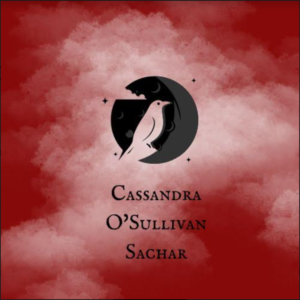
COS: https://cassandraosullivansachar.com/; @cosachar (Instagam)
About the Author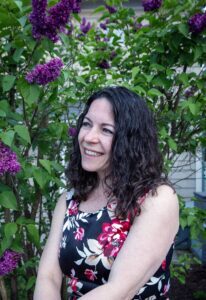
Cassandra O’Sullivan Sachar is a writer and associate professor of English at Bloomsburg University of Pennsylvania, where she teaches courses in creative writing, first-year composition, and composition theory. A former English teacher in Delaware public schools, she received her Doctorate of Education with a Literacy Specialization from the University of Delaware and her M.F.A. in Creative Writing with a focus on horror fiction from Wilkes University.
Dr. Sachar is the author of the dark suspense novel Darkness There but Something More (published by Wicked House Publishing in March 2024) and the short horror story collection Keeper of Corpses and Other Dark Tales (forthcoming from Velox Books in 2024). Furthermore, she is the editor of a multi-author volume on horror scholarship, No More Haunted Dolls: Horror Fiction that Transcends the Tropes, forthcoming from Vernon Press in 2024.
A member of the Horror Writers Association, she has placed horror stories and essays in numerous publications including The Horror Zine, HorrorAddicts.net, The Angry Gable, The Chamber Magazine, and Tales from the Moonlit Path. She has chaired panels on and presented horror scholarship at the Northeast Modern Language Association (NeMLA) Convention and the Ann Radcliffe Academic Conference. She has additionally served as the fiction editor for River & South Review and will soon begin as the creative prose editor of Pennsylvania English. Her research studies and practitioner articles have appeared in diverse educational publications.
The post Interview with Author Cassandra O’Sullivan Sachar: Darkness There but Something More, Keeper of Corpses and Other Dark Tales, and No More Haunted Dolls appeared first on L. Andrew Cooper's Horrific Scribblings.
March 20, 2024
Interview with Author Izzy Lee: I Can See Your Lies
Fin’s reality is crumbling. Her husband has abandoned her, she’s now a single mom to a nine-year-old daughter, her Los Angeles home is sweltering, and she’s being haunted by disturbing hallucinations that make life a waking nightmare. Are the visions a product of stress, trauma, psychosis, or something else? The answers to those questions become clearer when Fin starts digging up dark secrets connected to her mother’s cold-case disappearance, a once-rising actress who mysteriously vanished in 1979. Will Fin slowly unravel the truth? Or will it remain hidden forever beneath the glitz and glamour of illusion?
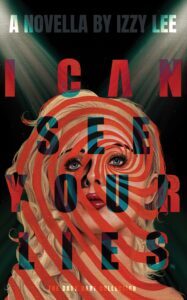 Click the pic for more on Amazon!The Interview
Click the pic for more on Amazon!The Interview1) Seeing Lies. Fin, your protagonist, seems able actually to see when a person is lying because a liar’s face changes rather grotesquely. Why does Fin’s ability manifest in the way that it does (yours to reveal… or not)? For Fin, is the difference between lies and truth black and white, or does her way of seeing acknowledge matters of degree? While much of the story involves conflicts in which abusive, controlling men are at fault, Fin’s ability, which she considers a “curse,” is passed along her family’s maternal line, and she has given a version of it to her daughter. Why is the ability to see truth passed among women?
IL: When people live in a world that’s made to hold them down with outright discrimination and in subtler ways, perhaps they develop special abilities. These abilities are not only a spotlight into the glaring system bias and disgusting behavior society has put in place as defaults–favoring the rulers of a culture made by and for themselves–but a protection. It’s the same rule that states the smarter you are, the more depressed you’re likely to be, because you see what’s happening in the world on the macro and micro level. You cannot avoid it, as much as you’d like to. A double-edged sword.
2) “Ever been othered.” At one point, experiences with men lead one female character to state that suffering from male coercion is the “story of every woman’s life,” which suggests the book might have at least some “everywoman” potential in its narrative. Is that right? Why or why not? In your “Acknowledgments,” you go further, writing that the book is for anyone who has “ever been othered,” which means a lot of people. Why so ambitious? How does the book work toward such ambition?
IL: There are a lot of hurt people in the world who need healing. I don’t think that’s ambitious, but human and empathetic.
3) Classic Gothic I: The Patriarchy. With its early horrors of a father imprisoning a daughter for daring to tell the truth about what she sees and a husband whose abuses seem to edge closer and closer to murder, I Can See Your Lies taps into the deepest veins of traditional horror, the first Gothic novels like those by Ann Radcliffe in the 1790s featuring young women trapped in castles by scheming male tyrants as well as descendants such as Charlotte Perkins Gilman’s “The Yellow Wallpaper” (1892). Were you conscious of this tradition as you wrote, and if so, how did it affect your writing? As far as the horrors of the patriarchy are concerned, do you think much has changed since the 1790s? Why or why not?
IL: There isn’t much that has changed, no. Some of the details and systems are different, and while there have, of course, been huge strides made in the last few centuries, you can’t tell me that a pink razor that costs a dollar more than a gray or blue one isn’t blatant sexism. It’s called the “pink tax.” It’s also why women’s dry cleaning and haircuts are more expensive, etc. etc. etc. Women still make on average 18 cents less than any man in the same exact position. It’s vulgar.
As for the Gothic, I’ve always been drawn to it, because I find these kinds of stories so relatable. Did I set out to write a Gothic tale? No. But the parallels are there because that’s the kind of life I’ve been subjected to. Fun times!
4) Classic Gothic II: The Manuscript. The first Gothic novel passed itself off as a rediscovered older manuscript, and after that Gothic/horror stories in print never really got over making manuscripts and books integral parts of their plots. So, too, I Can See Your Lies: Fin develops a riveting relationship with her missing mother’s diary, which is integral to multiple intertwined mysteries. Again, were you conscious of this manuscript tradition as you wrote, and if so, how did it affect your writing? How do you think your audience’s reading experience relates to Fin’s reading experience? How do you expect Fin’s reactions to the diary affect your audience’s reactions?
IL: I wrote this book almost as a stream of consciousness. It just came pouring out of me without any plotting, outlines, or thinking about any kind of works or traditions. I don’t know much about my readers’ reactions yet, except through reviews and some press I’ve gotten. Generally, women really relate to this book. I’m happy that it’s making an impact, that readers find it to be a realistic portrayal of a woman’s experience. It also makes me sad that what I’ve written is so familiar an experience. This society is garbage.
5) Hollywood (Neo-)Noir. Fin “found the Hollywood machine repellant to anyone with a soul.” Gothic isn’t the only supplier for the I Can See Your Lies cocktail: especially in the storyline involving older (as the 1970s isn’t quite “Old,” though you do capture that vibe) Hollywood, you play with noir figures, brooding, possessive men, the women they can’t resist, and the sex everyone’s having that seems to tempt violence at every turn. What drew you to such a representation of Tinseltown? To what extent does it reflect your actual feelings?
IL: I’m a big fan of noir and neo-noir stories and films, along with Gothic works. I think that one’s deepest influences cannot be separated from their creations. As for Hollywood? It’s a cruel god. The sun can shine on you one day, and the next, there’s an earthquake that’s destroyed you. There’s always a dark side to the brightest light.
6) Dark Inspiration. I’ve mentioned Radcliffe and Gilman, but I really thought more about Daphne DuMaurier… but enough about me. I’ve been tying you to solid traditions, but I think I owe you room to speak more generally: what/who were your literary and cinematic influences as I Can See Your Lies grew from inkling to novella? The book is divided into acts, and you’re also a filmmaker. Did the story unfold cinematically in your head? Do you plan to adapt it? Why or why not?
IL: I thought about this story as a film first, but I wanted to see where I could go and what could happen if I reverse-engineered it, in a way. I’ve written several short stories that have been published in various anthologies and magazines, and I needed to try to see if I could write something longer, so I did. It was wonderful to experience that I was accepted for publication on my very first try with the manuscript. What’s next? I’m either now going to write the script or work on the next book; I’m not sure what I’ll do first, though I may work on a few things at once.
The plan was always to make I Can See Your Lies into a film. Writing a book is hard. Making a film is inherently more difficult because of the amount of money and people involved. Can you find a producer who believes in you enough to try to pre-sell a film? Can you, a woman creator with a very female story, find funding in an extremely male-dominated system that funds and promotes male stories, run by men and made by men, above all else? Even female stories are told primarily by men. If you’re lucky to have gotten the funding, you’re still on a long, long road where anything can happen. When writing a book, you only have to rely on yourself up until you start querying for publishers and/or agents and then finally, press.
7) Dissociative Orders. Fin has a history of institutionalization, thinks about her training for dealing with anxiety, and thinks explicitly about her experiences with dissociation and “losing time.” How much, if any, research on dissociation and dissociative disorders did you do as you crafted Fin’s experiences? Dissociative disorders in particular have a long history of being tied to the supernatural. How does your book relate to and possibly reflect on that history?
IL: There’s a ton of information out there available to anyone interested enough to look it up. I learned a lot just by researching the things I’ve had to suffer through myself. I think that a lot of these conditions classified as disorders by our outdated mental health system is really just a way to describe how we feel after such dehumanization. I’m glad to see that people are being more open. It’s pretty valid to feel such things and go through experiences under a regime of non-stop oppression. Being repressed, oppressed, discriminated against, and abused in a world that’s not meant for you to thrive in, but to serve? Yeah, you’re damn right that you’d dissociate from time to time and have a hard time living in a culture that actively works against you.
8) House of Ashes. In the “Acknowledgments,” you mention that the writing of I Can See Your Lies coincided with embarking on your first feature film, House of Ashes, and word about that film is how I first discovered you. Tease us a little. What’s the film about, and why will we love it? What does it have in common with I Can See Your Lies?
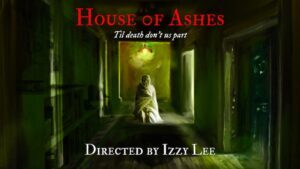 Concept art by Erik Wilson
Concept art by Erik WilsonIL: Both works handle dark emotions and journeys that follow oppressed women in extraordinary circumstances. House of Ashes centers on Mia, who’s under house arrest for the crime of having a miscarriage in my home, the ever-terrifying United States of America. Women’s rights have been constantly stripped by a group of people who want to throw us back into the past, and it’s horrifying that what we’ve written is now real. Anyway, Mia is under an unbelievable amount of stress in House of Ashes. She grieves the loss of her baby, job, and husband in this film. At the same time, she must contend with forces beyond her control, such as: a system that constantly judges and condemns her; a new boyfriend who may or may not have good intentions who’s moved in with her (way too early in the relationship) to help her out; a shady probation officer; invasive neighbors and podcasters; and possible supernatural events. All this while she’s unable to leave the house–or she’ll face arrest again and an even heavier sentence.
9) Access. How can readers learn more about you and your works (please provide any links you want to share)?
Nihilnoctem.com is where to go; my site has social media links as well. I Can See Your Lies is available online at Dark Matter Ink, Amazon, Bookshop.org, and Barnes and Noble. Some cool indie bookstores may have a few signed copies left, such as Dark Delicacies and the Lahaska Bookshop. Coming up in June, I’ll be signing books at the upcoming Chattanooga Film Festival and I’ll be running around at StokerCon. Thanks for the interview!
About the Author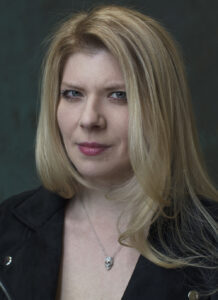
Named as one of A.V. Club’s 10 female filmmakers to hire, Izzy Lee is a director and author on the rise. Lee has directed more than two dozen shorts and shadowed director Adam Egypt Mortimer on the SpectreVision film Archenemy. She’s currently in post on a long-awaited feature film, House of Ashes. Several of her short stories have found publication, including “The Beginning” in Dark Matter Ink’s Haunted Reels anthology, curated by David Lawson, Jr. Released on 2/13/24, I Can See Your Lies is her first book, from Dark Hart Books & Dark Matter Ink.
The post Interview with Author Izzy Lee: I Can See Your Lies appeared first on L. Andrew Cooper's Horrific Scribblings.
March 13, 2024
Interview with Author Grace Anderson: The Labyrinth in the Closet and Green Pines
Emerging author Grace Anderson talks about generational trauma, the boundaries of gender, and the power of paranoia in this interview about her books The Labyrinth in the Closet and Green Pines.
The Labyrinth in the ClosetAfter a spell of boredom on a hot summer day in 1958, twelve-year-old Lois and her friends stumble across a mysterious passageway hidden in the back of her mother’s closet. They discover a mysterious map that points to treasure for those brave enough to seek it out. The four girls embark on a journey through this strange labyrinth in search of the promised riches. However, the labyrinth is not as innocent as it appears, and the obstacles it throws at the girls threaten both their friendships and their lives.
The Goonies meets Alice in Wonderland, this dark fairy tale adventure is sure to keep you on the edge of your seat.
A young man named Gavin is struggling to provide for his young sister after the death of their parents. When he is offered a job at an isolated campground, he accepts it in hopes of providing a better life for his sister. However, the campground soon proves to be more than what it seems, as a series of strange occurrences causes Gavin to question his sanity and the safety of himself and his sister. With the help of his coworkers and best friend, a conspiracy theorist, Gavin sets out to uncover the truth behind the mysterious campground. However, will he survive the sinister forces that lurk within?
The Interview1. Labyrinthine Youth. Though both Labyrinth in the Closet and Green Pines qualify as “dark fiction,” one of Labyrinth in the Closet’s main categories on Amazon—I think rightly—is “Coming of Age Fantasy.” The main characters are kids, the violence of their adventure is relatively mild, and though the older kids drop some f-bombs, the story offers little to offend. What age ranges do you think will respond best to the book? As characters work their way through the labyrinth, they also work through conflicts that require mature reasoning. To what extent is the labyrinth a metaphor for coming of age itself? What attracted you to the idea of kids struggling through a labyrinth for your story and setting?
GA: The idea for The Labyrinth in the Closet came about when I decided I wanted to write a female counterpart to The Goonies. The Goonies is widely considered to be enjoyable and relatable to all ages despite the main characters being children. I’d like to think The Labyrinth in the Closet has the same effect.
The labyrinth in the book is supposed to be more of a metaphor for a tragic loss of innocence rather than a traditional coming of age. The Labyrinth is a metaphor for the loss of the simple, idealized version of the world that occurs as a child grows up. The girls are discovering that the world is more dark, dangerous, and complicated than they once believed it to be. The labyrinth is a physical representation of that.
I found the idea of the labyrinth attractive due to the universal mystery of it. The Labyrinth in the Closet was very loosely inspired by Coraline, one of my childhood favorite books and movies. I took the idea of a wide expansive portal world hidden away in a seemingly normal unassuming house from that story. I always liked the idea of something strange and otherworldly being hidden away in something that would usually be considered mundane.
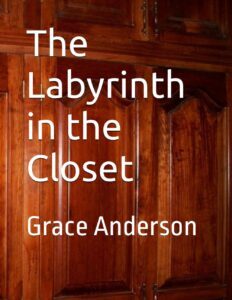
2. Dark Inheritance. A lot of the darkness in Labyrinth in the Closet appears in the characters’ backstories, particularly in their parents’ histories and the ways those histories have affected them—trauma, depression, alcoholism, and a detailed episode involving sexual exploitation of a minor. Why do you focus on these dark histories and their impacts on the younger generation? Do you think your characters are unusual as heirs to so much trouble, or do you think most kids inherit similar baggage? What are you saying about kids charting their own identities while still in the shadows of prior generations?
GA: All of my work centers around generational trauma. I believe what kind of family situation a character grew up in is an important factor in understanding them and why they think and act the way they do.
I think all children are impacted by their parents’ traumas. The mental state and experiences of a parent have a massive impact on how they raise their children and thus the kind of people their children become. That is something that I feel is worth exploring and dissecting through fiction.
Another theme I aimed to explore in The Labyrinth in the Closet is how children carve out their own identities and life paths in the wake of generational trauma. When the girls are in the labyrinth, they are free from the control and guidance of their parents. They are experiencing their first taste of independence, but even so, they can never be completely free from their parents’ traumas. The experiences of their parents are always going to shape the people they become.
3. Histories in History. Although I’m not sure the book provides a specific date, the description of Labyrinth in the Closet says it’s set in 1958, which fits with the book’s details. Why did you choose this time period? How does it affect the story and characters? How might the story and characters differ if the setting were in the present?
GA: All of my works are set in some kind of past time period. I believe the overuse of things like modern technologies and slang really ages a work of fiction and makes it less timeless.
I chose 1958 in particular due to the restrictive gender roles of that time period. The girls in the story are a lot rougher and crasser than what was expected of girls and women in the 1950s. I felt like that was an interesting subversion.
I think the addition of modern items like cell phones and the internet would be detrimental to the story as a whole. Setting the story in modern times would take away from the mystique and atmosphere.
4. Girls Trying to Escape. The kids who go on the adventure in Labyrinth in the Closet are all girls. To what extent is the book specifically an examination of female friendship, and what dynamics do you bring to the fore? So much of the story focuses on trying to escape feelings of entrapment and fearing punishment from strict parents—are you saying something in particular about difficulties girls face growing up? How might adding a boy to the group have changed your vision?
GA: The dynamic between the girls was written the way it was to subvert the expectation that young girls are always sweet and soft, especially during that time period. The girls fight, they cuss at each other, and they’re pretty cruel to one another at times. I feel like this is a more realistic and raw depiction of how young girls interact with each other.
There are definitely themes of how girls are treated harshly by their parents and by extension by society. There are certain behavioral expectations placed on young girls that may not be entirely achievable all the time. Young girls of that time were not really allowed to openly express their emotions and opinions without negative consequences from both their parents and society as a whole. I think a lot of aspects of that ring true even today.
It was important to me to have an all-female cast of characters so I could explore female friendship dynamics and gender expectations. Honestly, if I added a boy to the cast, I think the girls would eat him alive.
5. Changing Categories. The Labyrinth in the Closet has many dark elements and flirts with the supernatural, but Green Pines falls more squarely into “horror” categories. What makes Green Pines horror, and what inspired you to travel more deeply into darkness for this book? Do you think audiences for the two books are the same? Why or why not?
GA: I wrote The Labyrinth in the Closet with a more realistic (relatively speaking), magical realism story in mind. I’m a horror author first and foremost. I’ve been writing horror since I was nine years old, but for my first published full-length novella, I wanted to venture more into fantasy territory and save the more disturbing material for when I found my footing as an author.
I think the same people who enjoyed Green Pines will enjoy The Labyrinth in the Closet, but if a reader is particularly sensitive to disturbing themes, they may prefer The Labyrinth in the Closet.
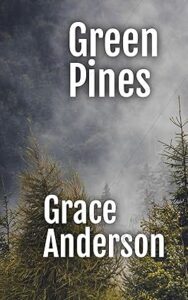
6. More Parent Problems. In The Labyrinth in the Closet, parents are usually problematic or absent, and in Green Pines, the main characters’ parents are dead, leaving the older brother to care for his younger sister. What drew you to make parent problems a catalyst for conflict, internal and external, again in Green Pines? How traumatized are Gavin and his sister by the loss of their parents, and how does that trauma shape the story?
GA: I’ve known many people who have lived with abusive alcoholic parents in my personal life. I know how deep of a wound that can leave on a person’s psyche. We experience all the challenges and tragedies of being human through stories. Because of this, I’ve always thought that generational trauma is a very important thing to explore through fiction, particularly when it comes to things like abuse and addiction.
The trauma that Gavin and Rosie experience both brings them closer together and causes a lot of stress between them. It also forces them to persevere through all the challenges they face together. In the beginning, Gavin is not very confident in his ability to properly care for Rosie, but he still takes responsibility for her because he has no other choice. Despite the book’s ending, Gavin grows as a character and becomes stronger through this sense of responsibility.
7. Questioning Sanity. The strange occurrences at the campground in Green Pines make Gavin question his sanity. Your bio emphasizes that your “work centers around grief, mental health, and all the emotional ups and downs that come with being human.” How do you represent Gavin’s struggles with his sanity, and how central are those struggles to the book? Should readers expect to question his sanity along with him?
GA: The nature of the Green Pines campground is to make its workers question their sanity. This is how it maintains its control over its victims. This manipulation is central to the main conflict and encourages the readers to question what is real and not real right along with the characters.
8. Conspiracy! The description of Green Pines lists a “conspiracy theorist” among Gavin’s helpers. How much of the story revolves around possible conspiracies and conspiratorial thinking? Together with strange occurrences that lead one to question one’s sanity, the presence of conspiratorial thinking suggests that you’re exploring one of horror fiction’s most venerable subjects—paranoia. Would you describe Green Pines as a paranoid tale? Why or why not? Are the characters paranoid? Will readers feel paranoid as they follow Gavin in trying to solve the mysteries?
GA: Timothy is the conspiracy theorist of the group. All the other characters roll their eyes at his ideas that they deem unreasonable or even crazy until he is ultimately proven right. This creates a lot of growth in the characters and tension in the plot.
Paranoia is an important aspect of all effective horror stories, so I tried to utilize it as much as possible in Green Pines.
The events in Green Pines are meant to provoke paranoia in both the characters and the reader. They’re supposed to make you question what is real and what’s not real. That is where most of the scares and tension stem from.
9. Access. How can readers learn more about you and your works (please provide any links you want to share)?
GA: https://graceandersonauthor.com/
https://www.instagram.com/graceandersonauthor/
https://www.tiktok.com/@graceandersonauthor?lang=en
About the Author
Grace Anderson is an up-and-coming indie author based out of Denver, Colorado. Her work centers around grief, mental health, and all the emotional ups and downs that come with being human. When she’s not writing, she enjoys reading, thrift shopping and sipping chai at local coffee shops.
The post Interview with Author Grace Anderson: The Labyrinth in the Closet and Green Pines appeared first on L. Andrew Cooper's Horrific Scribblings.
March 6, 2024
Interview with Filmmaker Rakefet Abergel: “Jax in Love,” “Boo,” and “Still”
Accomplished filmmaker is here to discuss three of her short films, destined for an anthology disc in the very near future, that explore horrific experiences with unusual perspectives that lead to jolting twists. Two of the films you can see now on YouTube and Amazon Prime!
“Jax in Love”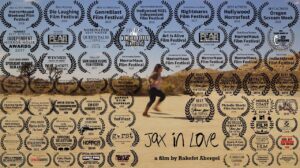 Click for “Jax in Love” on Amazon!
Click for “Jax in Love” on Amazon!Jax, a lonely wanderer, is searching for a human connection. How far would YOU go for love?
A mysterious and lonely young woman, Jax (Rakefet Abergel) is traveling through the expansive desert of the American West, in search of some tangible connection, a kindred spirit or like-minded soul with whom she can bond. When her car breaks down in the middle of nowhere, her journey takes a dangerous turn, and we learn this seemingly sweet woman may not be who she seems at all. How far will she go for love? Will she make it out of the desert alive? (20:19)
“Boo”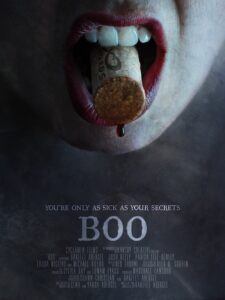 Click for “Boo” on Amazon!
Click for “Boo” on Amazon!A traumatic event forces a recovering addict to face her demons, without her worried fiancé uncovering the truth.
Over the course of a rough night, Devi, seven years sober, must make a difficult choice between who she loves and what she loves. “Boo” is a tense tale of what happens when addiction threatens to get the best of one woman at exactly the wrong time. We all have our addictions. What’s yours? (14:10)
“Still”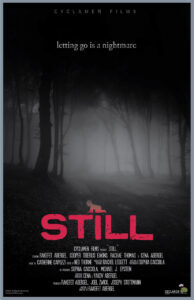 Coming soon! Click for a trailer!
Coming soon! Click for a trailer!A despondent mother’s reality crumbles as she faces the unthinkable. (11:45)
The Interview1. Women in/and Horror. Your films’ focus on women and female experience might justify calling them feminist. How do you think of them? Do you see any problem with associating the empowered or at least the center-screen feminine with horror? Why or why not?
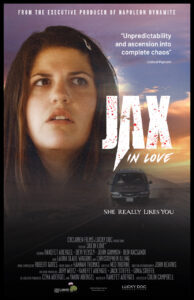 Click for “Jax in Love” on YouTube
Click for “Jax in Love” on YouTubeRA: I’m not sure if I would use the word “feminist” to describe them. I just think we haven’t seen enough horror with a female protagonist that isn’t being chased by a killer! I think there is something empowering about women being able to play the bad guys and about women being portrayed as complex characters who don’t just take their shirts off.
2. Not a Typical (Gothic) Romance. As the description suggests, “Jax in Love” begins with a lonely young woman stranded alone, in danger, perhaps, inherently for being a woman alone, a centuries-old horror trope the values of which your film does not necessarily share. How conscious were you of the tradition of such cautionary tales while creating “Jax in Love?” Do you think the film reinforces it, undermines it, or both? Why?
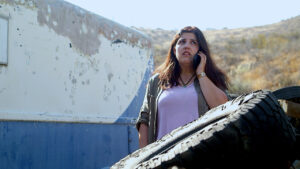
RA: I was definitely conscious of the stereotypical trope of a woman alone in the horror genre. I wanted to turn that on its head and use viewers’ expectations against them. I think the film definitely undermines the trope, showing that you can’t always believe what you see and that you don’t always know what to expect. I think there is value in that twist.
3. Atypical Encounters. As Jax encounters more people on her journey, the film eventually introduces the topic of mental illness, often a fraught issue in the horror genre. Here, the depiction seems more than usually thoughtful—in your view, how does “Jax in Love” reflect on mental illness? How sympathetic is it? How does your style convey the experience of atypical thoughts and perceptions?
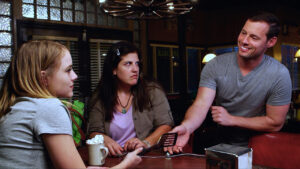
RA: Jax is a deeply troubled young woman with a lot of trauma behind her. I think the film is very sympathetic to her illness, even somewhat excusing her violent behavior with empathy for her condition and the reasons for it. I didn’t get too much into her back story in the short, but I’m developing a series around the character that explores her childhood trauma a lot more. I think there is something interesting about feeling sympathy for a character who is doing very bad things. Life isn’t a simple black and white equation; there are nuances and grey areas, and most villains are just heroes with the wrong intentions.
4. Jax in a Series. Your bio mentions that you’re working on a pilot version of “Jax in Love.” What can you reveal about the pilot and your vision for making Jax’s journey a series? What roles would you play in making the series (writer, producer, director, actor, etc.)?
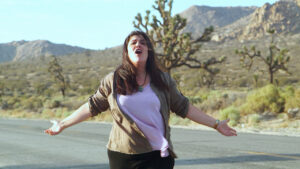
RA: I would definitely love to play Jax in the series, as well as direct. I would probably do most of the writing as well, at least up front. After that I would be happy to include other writers so that I could focus more on the other aspects. The series would explore her childhood and the various traumas she endured that culminated in her becoming who she is. I think it will give even more empathy to the character, and I also think the audience would end up cheering her on, much like we do with the lead in Dexter. To me that series is a nice parallel to what I’m trying to achieve.
5. Structured Scream. Most of “Boo” has a layered narrative structure, following two timelines, one leading up to and one following from a traumatic event. Why did you choose this structure, and how does it change (or I’d hope you say enhance) the viewing experience? How does it shape the development of Boo’s character?
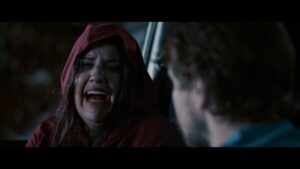 Click for “Boo” on YouTube!
Click for “Boo” on YouTube!RA: Originally the script was in chronological order, but a friend of mine read it and suggested I go with the dual timeline, which definitely makes it more exciting and tense. Again, I am using the viewer’s expectations against them when the twist is revealed. I rather like subverting expectation because I feel that I embody that dichotomy in my real life as well. People assume they know who you are, and most of the time I don’t fall into the category you might expect. I think that makes me more interesting, and I think that makes the characters more interesting as well.
6. Being Boo. I never want to overlook any aspect of filmmaking, but I do feel that the intensity of “Boo” depends largely on the intensity of your performance in the lead role—and the film is pretty darned intense. How do you feel about being your own star? When you’re conveying extreme emotions for the camera, how do you keep worrying about the shot’s framing from affecting your performance? In brief—how did you manage your multihyphenate status on “Boo”?
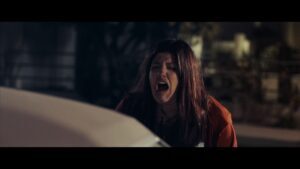
RA: It’s really tough to act and direct and produce at the same time. I do it because I truly love the first two things. The producing is something I’d happily give up to someone else if I had someone else to do it! Sometimes I wonder what it would be like to direct without having the burden of starring in it, but I love acting so much that I think I would be jealous of my own cast! The best way I’ve found to make sure I’m getting a good performance and a good shot is to have a really great crew behind me, especially in the roles of cinematographer, any other producers, and an excellent first A.D. A script supervisor with a keen attention to detail is another really important part of it. If you have enough people that you trust watching you and the monitor, it makes it a lot easier to focus on the performance.
7. Still, Genre. I can imagine many people wanting to classify “Still” as an art film or drama rather than a horror film. How do you think of it? Art film? Art horror? Whether or not we as artists think categories matter, we all must deal with them when we face marketing and distribution. What are the consequences of categorization for “Still”? What does the viewer gain and/or lose by going in expecting a horror film?
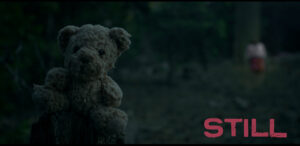
RA: “Still” is probably more drama than horror, or maybe psychological art horror. I know some festivals have already expressed that they aren’t sure where to put it. I honestly don’t think categories matter that much. Is the film good? Does it resonate with audiences? I think those are the things that matter. Horror is such a wide genre. There are so many types of horror. If people are going in expecting a slasher film, they will be very disappointed. But I think there are many horror films that aren’t typical horror but still fill you with dread, or sadness, or fear. Losing a baby is one of the most horrific experiences I can imagine. Sometimes horror isn’t about the body count or a murderer. Sometimes it’s about exploring an extremely horrific experience and what that can do to the human psyche. Even the first Saw movie wasn’t all that graphic. It was more about the horrific experience they were going through. Most of Hitchcock’s work wasn’t gory, and yet still insanely terrifying. Maybe for some people reliving an incredibly painful experience that no one wants to live through is horrific.
8. Still, Form. I would say “Still” tells two stories, one in the background about a traumatic event and one in the foreground about the protagonist’s, Aliya’s, emotional response to the trauma. As in both “Jax in Love” and “Boo” (which looks at addiction), “Still” examines a mental disorder, this time post-traumatic stress that disrupts film form to a degree where narrative doesn’t follow any clear timeline, often relying on match cuts and other editorial strategies to convey associational thinking. What inspired your narrative form? Would you describe it as abstract or surreal? Why or why not? Do you think a more typical form could have allowed you to explore the emotional experience you depict as accurately? Why or why not?
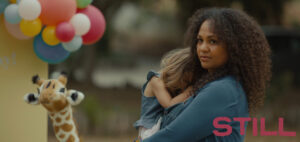
RA: So, our first cut of the film was according to the script, which didn’t rely on the unclear timeline or surrealism. And it came out very boring. The script isn’t plot based. It’s emotion based. And visually it just wasn’t working at first. So, I took a small crew up to the Angeles Forest to shoot some B roll, and I worked for many, many hours with our incredible editor, , on crafting something that we could visually FEEL instead of SEE. It wasn’t my original intention, but I think the way we ended up cutting it is much more intense, interesting, and emotionally charged. I would say it’s more surreal than abstract. When someone is in a state of mental distress, time doesn’t happen the same way. Things come and go. Grief is an ongoing wave that swells and retreats. I don’t think a more typical format would be more accurate. I think that a film about grief should make the viewer feel like they are going through it as well. And that’s what we tried to do with it. Whether we succeeded at that or not is up to the audiences!
9. Still, Intimacy. Your style in all three of these films often feels intimate, but perhaps because it focuses more on horrific feelings than horrific events, “Still” feels the most intimate. The intimacy comes sharply into focus when the memorial appears at the end of the film. Do you mind sharing the inspiration for “Still?” in general, how much does autobiography influence your art? To what extent, if at all, is self-expression through film therapeutic?
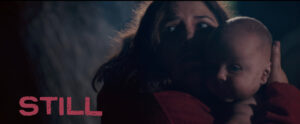
RA: “Still” was based on the feelings I had around the loss of my pregnancy in 2021. Although I was only pregnant for a short time, I had already imagined a lifetime with this child. I had already made plans, named him, told people about it, considered how my life might change. And when I lost him, I lost an entire future I thought I had, too. I don’t think people who haven’t gone through it realize that it’s more real than it seems. I wondered if people would say the same things they say to someone who’s miscarried if that child was already alive and somehow was lost. Because to me, it was like he was already here. And hearing things like “well at least it was early” or “you can always try again” felt so hurtful and dismissive. No one would say things like that to someone who lost a child that had already been alive.
All three films come from deeply traumatic experiences in my life. Emotions are how I navigate the world. Self-expression through film has been very therapeutic for me. Sometimes just exploring those feelings and putting them out there helps me feel that I am allowing myself to be understood better. Sometimes emotions are hard to convey, but film is such a terrific medium for that. Movies make us feel all sorts of things. They change our perceptions. They challenge our beliefs. And horror is a perfect genre to explore the darkest feelings. That’s why my films aren’t typical horror. For me the emotions and the reasons for them are horrific enough. I don’t feel the need to make something just for the sake of being scary. Love is scary. Addiction is scary. Grief is scary. Loss is scary. Emotions are scary. I think there’s room in horror for all kinds of scary.
10. Access! How can people learn more about you, view your films, purchase your films, and generally get access to your world (please provide any links you want to share)?
RA: I’m working on putting all three films onto a compilation DVD called Love Scars that will also include behind the scenes featurettes, trailers, pitch videos, music videos, possibly audio commentary, and more. For now, you can watch “Jax in Love” and “Boo” on various platforms including ALTER, YouTube, Red Coral Universe, Amazon Prime, ShortsTV, and various DVD and Blu-Ray anthologies.
“Still” is making the festival rounds this year and next and will be available online probably in 2025. You can watch the trailer and the music video with the original song “The Life We Never Had” by me and Sarah Smith, on both of our YouTube channels. The acoustic and electronic versions of the song are also streaming on all available music platforms.
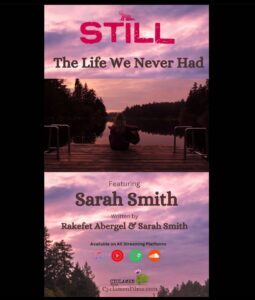 Click for the music video!
Click for the music video!You can follow me, the films, and my production company, Cyclamen Films here:
www.CyclamenFilms.com
www.facebook.com/RakefetAbergel
www.facebook.com/CycalmenFilms
www.facebook.com/StillAShortFilm
www.instagram.com/cyclamenfilms
About the Filmmaker Click for Abergel’s YouTube channel!
Click for Abergel’s YouTube channel!Rakefet Abergel is an accomplished director, writer, and producer known for her unique voice and creative vision. Born in Los Angeles, Abergel began her career in the entertainment industry as an actress, working in both film and television.
She enrolled in the film program at Boston University, where she honed her skills and developed her unique style. After several years of acting, Abergel shifted her attention to directing and writing.
In the last several years, she has produced and/or directed a couple of critically acclaimed short films, including “Jax in Love”, “Boo,” and currently, “Still”, all three of which she also wrote and starred in. Her films are streaming on ALTER, Bloody TV, ShortsTV and Amazon Prime and available on several DVD and Blu-ray anthologies.
Her writing, acting and directing have been recognized with numerous awards and honors and her films have screened at festivals around the world.
Abergel’s work is characterized by its bold, unflinching honesty, and her ability to explore complex themes and emotions in a way that is both authentic and relatable. Her films often explore issues related to identity, relationships, and personal growth, and she has been praised for her ability to tackle these topics with sensitivity and nuance.
In recent years, Abergel has continued to expand her portfolio and is currently in development on a pilot version of “Jax in Love” and several feature films.
She also teaches Hebrew and Bar/Bat Mitzvah studies to kids in Los Angeles, and works as an acting coach and mentor at Kid (F)Actor, an acting school she founded in 2010.
An established multihyphenate, Rakefet Abergel has proven herself as a force to be reckoned with in the entertainment industry. Her unique voice and creative vision have earned her a loyal following of fans and admirers, and her work continues to inspire and provoke audiences around the world.
The post Interview with Filmmaker Rakefet Abergel: “Jax in Love,” “Boo,” and “Still” appeared first on L. Andrew Cooper's Horrific Scribblings.
February 28, 2024
Interview with Filmmaker Gregory Blair: Deadly Revisions and The Mystery of Emma Thorn
A filmmaker who has demonstrated excellence in acting, writing, and directing, Gregory Blair is here to discuss two films in which the darkness lies as much in the unseen, deep in the psyche, as it does in the chills and thrills on the screen.
Deadly Revisions (Director’s Cut)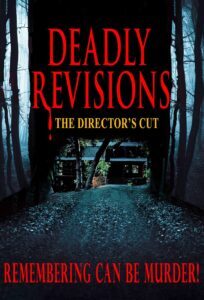 Click for more on Amazon!
Click for more on Amazon!An amnesiac horror writer becomes trapped in his own nightmare as terrifying images emerge that could be memories, madness, or both!
The Mystery of Emma Thorn (Filming May, 2024)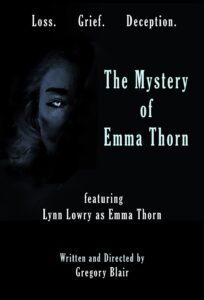
A woman’s unusual disappearance leaves her distraught husband and son—and a sympathetic police detective—to try to unravel the how and why.
The Interview1. Your Revisions. What’s the difference between the Director’s Cut of Deadly Revisions and the original? Why did you decide to do a Director’s Cut? Did you have any nightmares about the different versions, or, in this case, did life not imitate art?
GB: No nightmares in my real life, thankfully; I’d hate to experience what Grafton Torn does in the film! The reason for the Director’s Cut was my desire to improve the film. It won plenty of good reviews and awards as it was, but I always wanted to tweak different things after the first cut was out in the world. I think that as you grow as a filmmaker (and I hope I’m growing), you see things in your earlier works that you’d do differently. I’ll wager most filmmakers feel that; I just decided to act on it. So, the Director’s Cut was my opportunity to make as many of those tweaks as I could with the footage we had. There are small changes in editing, lighting, color—even effects that come across as camera movement: all things to tighten a scene or moment or give it more punch.
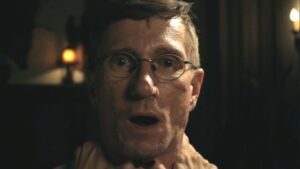
2. Writer Stories. “Writer Stories” with protagonists who write fiction are practically a horror subgenre, mostly thanks to Stephen King (though he didn’t invent them). To what extent, if at all, did you think about Stephen King and/or the “Writer Stories” phenomenon when creating Deadly Revisions? And, if not, why did you choose to focus on a writer for a horror movie?
GB: I didn’t intentionally decide to add to that genre slice. I had an idea for a novel where a horror writer was terrorized by his own creations, and that became the main idea that I turned into Deadly Revisions. The basis for the novel was intellectual and metaphorical and not particularly cinematic, so once I decided to turn the idea into a film, the whole story changed into something that would manifest well in that medium. Also, being a bit of a horror film fan, having written some horror fiction and scripts, as well as having a lot of peers entrenched in horror filmmaking, I thought it would be fun to create a piece that would both pay homage to and comment on the genre and its creators. The scene where Grafton is grilled in an interview about his work was very much born of that whole idea.
3. Writer Sanity. Thanks to Edgar Allan Poe and a few other figures, a lot of people have a romantic view of a thin line between creativity—particularly dark creativity—and madness. Deadly Revisions plays with the idea that horror writers might have a weaker grasp on sanity. Is there something to this idea? Either way, how do you think this idea about horror artists affects those artists and their art?
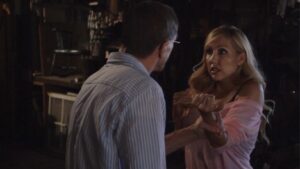
GB: While I think any correlation between a person’s art and their grasp of reality is best left to mental health professionals, I’d argue that it’s probably unfair to believe that a writer’s genre choice reveals much about their sanity. Mental illness is hardly discriminatory in that way. There are those outside of the industry who have a low opinion of the genre and its creators, thinking they all must be sick in the head. But, like most “holier than thou” types, those people often reveal their own hypocrisy by enjoying violent action films, video games, or blood sports. Moral high ground is usually shaky ground with skeletons just below the surface.
Moral high ground is usually shaky ground with skeletons just below the surface.
4. Cabin in the Woods. Okay, so it’s a house, but Grafton retreats to an isolated woodsy location early in the film, which aligns the film with the “Cabin in the Woods” tradition. Did this tradition make an impact on your film? What’s so useful about this setting?
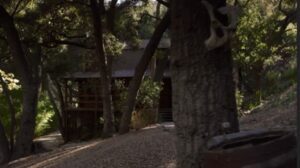
GB: The tradition stands because that setting provides a variety of things: narratively, an isolated location adds to a sense of loneliness, helplessness, entrapment—anything a storyteller may need to heighten the situation with which the character (or characters) must grapple; from a budgetary standpoint, a remote location usually avoids a host of issues (pricier permits, urban noise issues, etc.) and that usually helps keep costs lower. When something serves the narrative and is also budget-friendly, it’s easy to understand why filmmakers would take advantage of it.
5. Representing What Isn’t Present. What strategies involving lighting, shot distance, shot framing, editing, and other film techniques does Deadly Revisions use to represent memory… as well as experiences that may or may not be real?
GB: I think lighting and color play a big part in the film toward that idea. Many of the flashbacks/memories are contextually clear: we know we’re seeing something from the past. But often the color palette will be a little off, indicating that the memory may be off as well, meaning what we’re seeing may not be completely true. And then I played with that in the new version where a scene starts off looking normal and then the color suddenly goes wrong—just as we realize the scene is not reality. It was a way of using color as metaphor. Horror is famous for doing that in bold fashion, so it seemed appropriate.
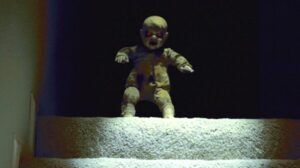
6. Mystery Surrounding Emma Thorn. IMDb only shares a scant amount of information about your film in pre-production, The Mystery of Emma Thorn. It classifies the film as a drama, but the title, of course, says “mystery.” How would you classify this film, and what sort(s) of audience(s) will it be right for?
GB: The Mystery of Emma Thorn is a blend of genres. On the one hand, it’s certainly a mystery about a missing woman, but it’s a character study and a family drama as well. Funny thing is, the original idea led me to think it would be a horror film, but as I started writing it, the honest emotions of the family members left behind came to the forefront, and I realized their story was more of a drama than anything else. Sure, there’s fear and dread lurking, but there’s also hope and the need to care for each other.
8. The Mysteries Ahead… In how much detail will you have planned the look and feel of The Mystery of Emma Thorn before you start to shoot? What can you tell us about the viewing experience you plan to construct?
GB: I’m a big believer in planning everything down to the finest detail: that way, we head into production with everyone having a clear picture of what we’ll be accomplishing each step of the way. That fosters efficient filmmaking. My extended shot list concept uses color shading to mark which shots will cover which lines: I know what line I want to be in the close up, what line I want to see in the wide, etc. That helps me direct more efficiently and helps the script supervisor know what the editing goals are, so they can make sure we haven’t missed anything. As for the feel of the film, I’m aiming for an almost dreamlike, hypnotic feel: I want people to be lulled by it…and then slowly start to become more and more engaged and intrigued as more information gets revealed and they start to get suspicious—just as some of the characters do.
9. Favorite Role? Your bio (below) states your multihyphenate status and then breaks it down by role, highlighting your accomplishments as actor, writer, and director. If you had to choose, what role would you say makes you happiest? What takes the most energy? Where do you hope to develop most in the future?
GB: This is a tough one, but I’d say acting would (still) win out, because it was the role I first fell in love with; everything else just branched out from that. And although a 7 ½ hour show like Angels in America does take a lot of energy out of an actor, directing indie film takes more out of me… which is why I don’t do a film every year like some people can. But that’s partly because in much of the indie film world, the director isn’t just a director: they are often also a producer, a UPM, the art department, and whatever else a production may need that the budget can’t afford. So, you’re often using multiple parts of your brain, moment to moment, the entire day, as the production needs shift… and that can be incredibly exhausting. Rewarding… but exhausting!
Thanks for the great questions! I hope I provided some insightful answers for your audience.
[Thanks, you did! – Andrew]
About the Filmmaker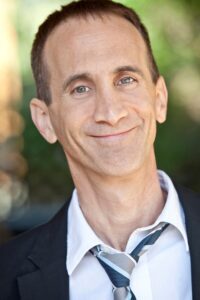
Gregory Blair is an award-winning actor, writer, director, and producer.
As an actor, Gregory has graced the stage (Angels in America, Working, Six Degrees of Separation, etc.), the big screen (Craving, Fang, Garden Party Massacre, etc.), and the small screen (Escape the Night, Love that Girl!, Deep Undercover, etc.). He was awarded “Best Actor” for his roles in Fang, Beasts of the Field, and Angels in America.
Gregory’s writing has been represented on stage (Cold Lang Syne, The Last Banana, and Nicholas Nickleby), in prose such as The Ritual, Little Shivers, and the Stonewall Award winning Spewing Pulp, and in films including the screenplays for Deadly Revisions, Garden Party Massacre, and the story for The Convent. He won the Claw Award for “Best Screenplay” for Deadly Revisions and a 2021 Impact Award for his screenplay Convenient Living.
Gregory directed the features Deadly Revisions and Garden Party Massacre as well as two shorts. He won the EOTM Award for “Best Director of an Indie Horror Film” and the Flicker Award for “Best Picture” for Deadly Revisions as was as handfuls of awards for Garden Party Massacre, including “Best Feature” from the Fantastic Horror Film Festival and “Best Director of the Year” from the Southern Sykos Film Festival. He is also the proud recipient of the esteemed Phil Tucket Spirit Award for filmmaking.
Gregory loves to teach as well as entertain, so he also provides writing consulting and enjoys being a guest speaker at learning events. In everything he does, Gregory’s goal is to entertain and enlighten people to make the world a little better for his having been there.
GREGORY BLAIR:
IMDb: https://rb.gy/yqkq4b
Official Website: www.gregoryblair.info
Facebook: https://www.facebook.com/TheGregoryBlair
Twitter (X): https://twitter.com/TheGregoryBlair
Instagram: https://www.instagram.com/thegregoryblair/
DEADLY REVISIONS (Director’s Cut)
Amazon: https://shorturl.at/uGWX3
Google Play: https://shorturl.at/hBIKT |
Trailer: https://rb.gy/mhp72
THE MYSTERY OF EMMA THORN:
Official site: http://www.2writers.com/TheMysteryOfEmmaThorn.htm
Facebook: https://www.facebook.com/profile.php?id=100092660858924
Teaser: https://youtu.be/Z36RUtVigbA
The post Interview with Filmmaker Gregory Blair: Deadly Revisions and The Mystery of Emma Thorn appeared first on L. Andrew Cooper's Horrific Scribblings.
February 21, 2024
Interview with Author Kristopher Triana: The Old Lady
Winner of multiple Splatterpunk Awards, smart and scary Kristopher Triana is here to discuss his just-released novel The Old Lady.
The Old Lady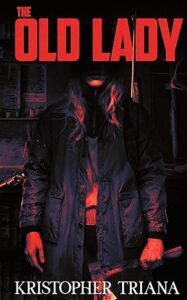 Click for more on Amazon!
Click for more on Amazon!She never wanted to come home.
After the death of her estranged father, Tracey returns to the remote cabin she grew up in. As a traumatized veteran of the Vietnam War, Tracey’s father subjected her to rigorous survival training under brutal conditions, believing it was for her own good. She escaped and never looked back. Now in her fifties with a criminal record, Tracey returns to claim the property she’s inherited.
Hiking through the forest, teenage Alicia and her friends get lost in the snow. They stumble upon a compound run by extremists, and when the teens see too much, only Alicia manages to escape. She searches for help and comes across a secluded cabin.
With the panicked girl banging on her door, Tracey is launched into combat mode, awakening her inner demons. Though she suffers from extreme PTSD, she is skilled in combat, making her a deadly adversary—perhaps too deadly. As a snowstorm hammers down, the women must work together to save Alicia’s friends from their captors.
Alicia has a protector now, but what if this strange old lady is even more dangerous than the people she’s escaped from?
The Old Lady is a new tale of survival horror from Kristopher Triana, author of Gone to See the River Man and Full Brutal, and columnist for Backwoods Survival Guide.
Traumatic Story, Traumatized Characters.
ANDREW: The description of The Old Lady arguably links Tracey’s father’s “traumatized” status to the “brutal conditions” of her childhood and Tracey’s own “extreme PTSD” to how “dangerous” she is. How would you describe The Old Lady’s representation of trauma?
KRIS: I like to think it’s a realistic, sympathetic examination of trauma and the lasting effects of it. Everyone has bad memories and personal pain, but trauma is much deeper than that. With the character of Tracey, I delved into the struggles people with trauma face, including some stuff from my own personal experiences with it. Sometimes we must show the ugly side of things to tell the story accurately.
ANDREW: Do characters’ experiences with trauma contribute to their capacities for violence? Why or why not?
KRIS: No, not always. People with trauma or mental illness aren’t automatically more violent than anyone else. But from a character standpoint, a traumatic past can help explain a character’s reactions to certain situations or threats, reactions that may seem irrational or out of proportion to others who haven’t experienced what they have. In the case of Tracey in The Old Lady, her traumas are plentiful and extreme. She’s endured more than your average person can even fathom. Her violence is reactionary, but her skills at combat stem from her survival training, not her trauma.
ANDREW: How do you feel about the representation of mental illness in horror more generally?
KRIS: I find that mental illness is too often demonized by horror entertainment. Most of the time when we see characters with mental illnesses, they’re complete maniacs in asylums that look more like haunted house attractions than care facilities. As someone who suffers from bipolar disorder, I find such representations insensitive, and as a horror writer, I find them lazy and unimaginative. Negative portrayals like these only further perpetuate the inaccurate, hateful idea that people with mental illnesses are monsters to be feared.
Versus Nature.
ANDREW: After reading Gone to the See the River Man and gearing up for The Old Lady, I see that hiking is again a feature, and characters are going to face a snowstorm. I flash back to middle school and identify “humanity versus nature” as a central conflict. What draws you to such settings and conflicts?
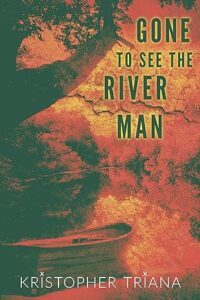
KRIS: There’s something primal about the woods. The only thing you can rely on there is yourself. I like how nature forces us to revert to humankind’s old ways in order to survive. People fear being alone in the woods because there are no safety nets like the ones we have in our so-called civilized world. The woods are dangerous, cold, and dark, reminding us that our lives could be that way so easily.
ANDREW: How central is such conflict to The Old Lady?
KRIS: It’s a huge element.
ANDREW: What does it add to the story, particularly the horror factor?
KRIS: The story takes place deep in the White Mountains of New Hampshire during a terrible snowstorm. Extreme weather is scary in and of itself, so it’s always a welcome addition to any good horror story. Just look at John Carpenter’s The Thing or White by Tim Lebbon. The snow in those stories is as much a threat as the monsters.
ANDREW: In Gone to See the River Man, the line between natural and supernatural gets blurry—can readers expect the same in The Old Lady?
KRIS: No. The Old Lady takes place in a real world setting and has no supernatural elements. But the horror is just as disturbing, transgressive, and brutal as anything I’ve ever written, and I think the story’s realism makes the violence hit that much harder. This is a brutal nightmare that could happen to any of us at any time.
Survivalism.
ANDREW: With Tracey and her father, The Old Lady peeks into the world of survivalists and survivalism. What’s your view (as a contributor to the Backwoods Survival Guide) of survivalist culture, and does your novel reflect that view?
KRIS: I have an interest in survival techniques. I love the outdoors and have always strived to be as self-reliant as possible. I like to do things for myself, fix things myself, figure things out myself. Some of that comes from being a loner, but another part is just an old school mentality regarding what it means to be a man. Much like Tracey’s father in The Old Lady, my father was a Vietnam Veteran, and his experiences in that war changed him for life. We always had canned goods, gallons of water, and enough guns to open our own store if we wanted to. As I got older, I grew to respect the survival mentality more, especially after living through several natural disasters. Some people laugh at those of us who prepare for the worst, but when the worst happens, the laughter stops, and we’re the first ones who get called on for help. Let’s just say that when the Covid shortages hit, I was never short on toilet paper.
ANDREW: Does the novel suggest any relation between survivalism and the “extremist” culture that Alicia encounters? If so, what’s the connection? If not, how do you avoid parallels?
KRIS: There is a stigma that comes with being a survivalist. There are people who automatically assume you’re an alt-right loon just for having the tools and supplies needed to take care of yourself and your loved ones. But those people are only kept safe in times of crisis by people more diligent than themselves. That said, there are certainly the extremists types out there. In The Old Lady, I tried to show both sides of this. I show how useful prepping and survival skills really are to everyday people, but also feature demented militia characters who use survival skills in their acts of terror.
Survival Horror, pt. 1.
ANDREW: Amazon advertises The Old Lady as “survival horror.” How does “survival horror” relate to splatterpunk/hardcore/extreme horror?
KRIS: Survival horror is exactly what it sounds like. In a way, all horror is survival horror, because if the protagonist fails, they die. But true survival horror involves anti-heroes, not simple victims. A good example of a survival horror story is Richard Matheson’s I Am Legend—the last man on earth struggling to survive in a world overrun by vampires. He’s not just running—he’s fighting back.
ANDREW: How hardcore is The Old Lady?
KRIS: It’s not as gross or sexually aberrant as say, Body Art or Toxic Love, but the violence is extremely brutal, and the gore runs like a red river. Characters are mutilated, set on fire, tortured, and blown to bits. Fans of my hardcore works will not be disappointed. But the book also has layered characters and a realistic storyline, making it more like a sister book to A Fine Evening in Hell or Shepherd of the Black Sheep.
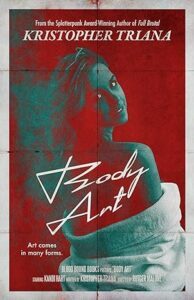
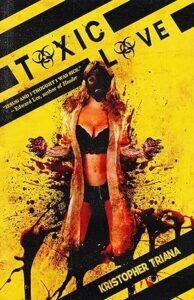
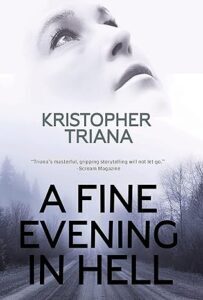
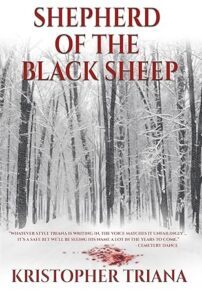
ANDREW: How do you feel The Old Lady connects to your other works? With which of your works does The Old Lady resonate most?
KRIS: I think it’s the perfect balance between the hardcore, unhinged horror of Full Brutal and the grim realism of A Fine Evening in Hell.
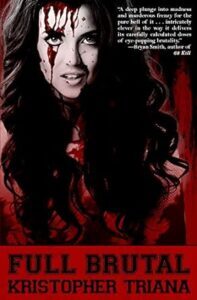
Survival Horror, pt. 2.
ANDREW: The term “survival horror” has gotten around some, actually. It makes me think of video games, which is the realm where I probably encountered the term first. It also makes me think of one of the terms applied to films like those in the Saw franchise when people are trying to be nice. How might video games, films, or other media have influenced The Old Lady?
KRIS: I’m not a gamer, but I can understand why you’d connect the two. I think the 1980s one-man-army movies I loved as a kid played a big role in the development of this story, especially the Rambo movies.
ANDREW: More generally, what artists and/or works would you say had the greatest impact on this novel’s story and style?
KRIS: Jack Ketchum and David Morrell. Two authors I’ve admired for decades now.
Writing Women.
ANDREW: Many of your stories’ protagonists are women. Why do you focus on female characters? What insights drive your representation of women’s perspectives?
KRIS: Many years ago, I made it a point to write female characters better. So, I started reading more books written by women, especially horror books. It helped me better understand not just female writers but female readers. Since then, I’ve been attracted to female-lead narratives. I think strong female characters are underrepresented by male authors, and in the world of horror fiction, women are too often just final girls/victims. I like to give them much more to do, including having them be the ones swinging the axe!
ANDREW: Do you feel you return to women’s perspectives so often in your work more by coincidence or by design? Why?
KRIS: I just go where the story takes me. It reveals which characters will be the most interesting and fun to write. Sometimes they’re women, sometimes not.
Collaboration.
ANDREW: In The Old Lady, Alicia and Tracey “must work together,” suggesting that collaboration may be a key component of the book’s vision for survival. What do you think the book says about collaboration, particularly across a generational divide?
KRIS: Working together is key to any group’s survival. In The Old Lady, Alicia and her friends work with Tracey, but they are teenagers, and Tracey is in her late fifties. In their eyes, she’s an old lady. But she has survival skills the teens do not, so they rely on her to get them through this horrific experience. I also think it’s a little bit of the old man in me trying to prove a point to young people that they don’t know everything, shouldn’t rely on computers so much, and should at least listen when older people give them advice, because with age comes experience and wisdom.
ANDREW: You’re no stranger to collaboration, having taken home a Splatterpunk Award for The Night Stockers, which you co-authored with Ryan Harding, and being involved in a collaboration with Wrath James White (I get White’s newsletter). How do you feel about the collaborative writing process compared to going solo?
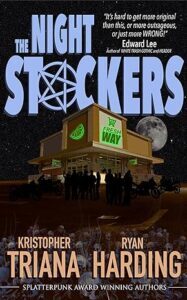
KRIS: A collaboration can be a lot of fun and produce an exceptional final product, particularly when you’re working with people you like and admire for the skills they bring to the table. Ryan and Wrath are both friends of mine, so we have a lot of laughs working together. There’s a bond that comes with creating something as a duo, whatever it is. But you must have the right partner, someone who works at the same pace and wants the project to go in the same direction as you do.
ANDREW: Can you reveal anything about your work with White?
KRIS: Just that it will be as bloody, sexy, and deranged as you’d expect from a White/Triana collab!
Future.
ANDREW: Speaking of revelations, what else are you working on?
I have a collaborative work with Mona Kabbani coming out this spring, in which we both wrote separate novellas with same theme—what we call “extreme horror romance.” And a new solo novel will likely come out before the year ends, too. There are other projects, but none I can divulge at this time.
ANDREW: Where can readers, returning and new, expect to follow you once they’ve enjoyed The Old Lady?
KRIS: Follow my free Substack newsletter for updates and exclusive content.
Access.
ANDREW: And speaking of following you… how can readers learn more about you and your works (please provide any links you want to share)?
SUBSTACK: https://kristophertriana.substack.com
FACEBOOK: https://www.facebook.com/reverendgator
INSTAGRAM: https://www.instagram.com/kristopher_triana/
TIKTOK: https://www.tiktok.com/@kristophertriana
About the Author
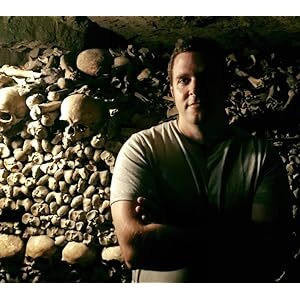
Kristopher Triana is an author of horror and crime fiction.
His novels include Full Brutal (Winner of the 2019 Splatterpunk Award for Best Horror Novel), Gone to See the River Man, Shepherd of the Black Sheep, The Thirteenth Koyote, and many more. He has authored two short story collections, Blood Relations and Growing Dark, the latter of which was called “a must read” by Rue Morgue Magazine. His books have been translated into multiple languages, and his short stories have appeared in many magazines and anthologies, including Chiral Mad 4, Cemetery Dance, and The Year’s Best Hardcore Horror, to name a few.
His work has drawn praise from Publisher’s Weekly, Scream Magazine, Rue Morgue Magazine, Cemetery Dance, The Horror Fiction Review, and The Ginger Nuts of Horror.
He lives in Connecticut.
Follow him at: kristophertriana.com
The post Interview with Author Kristopher Triana: The Old Lady appeared first on L. Andrew Cooper's Horrific Scribblings.
February 14, 2024
Interview with Filmmaker Michael Kallio: The Scout, Inner Demons, and More
Michael Kallio, a unique combination of experimental filmmaker and crowd-pleaser, reveals the thinking behind his magic as we discuss a few of his films.
The Scout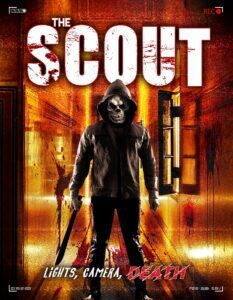 Click for the movie on Google Play!
Click for the movie on Google Play!An independent film crew on a group location scout are attacked by a mysterious masked killer, who appears “hell-bent” on murdering them one by one. Think Scream 3 and Waiting for Guffman meets The Office with more blood… LOL.
Inner Demons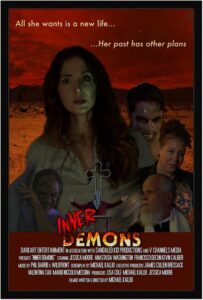 Available later in 2024!
Available later in 2024!After a near death experience, a woman with a troubled past is tortured by visions and hallucinations as she fears she has brought something back with her from the afterlife. The woman becomes terrified her “inner demons” will take control to the point of no return. Is it too late to save her own soul? An ode to the creepy, atmospheric horror films Carnival of Souls and Jacob’s Ladder, with a smidgen of Drag Me to Hell and Evil Dead thrown in.
The Interview1. Financing Horrors. In our correspondence, you mentioned the ultra-low budgets of some of your films. How do you make such watchable movies with such low price tags? At what point do you start considering budget—the first time you jot down an idea, or at some other point in the process? What advice do you have for other writer-producer-directors working on shoestrings? To what extent does The Scout spoof as well as showcase low-budget restrictions?
MK: I’m glad you thought they were WATCHABLE… LOL. In all seriousness, thank you. I am glad you liked both The Scout and Inner Demons. Making a movie can be very tricky, so I am always pleased when people enjoy them.
To answer your first question, you do what you can with what you have… meaning, I take the budget into consideration before I really start writing. I had been considering doing a micro/no budget movie before I was approached to do The Scout back in 2020. When I read the initial script written by Anthony Leone, knowing the budget would be less than a crappy used car, I had ideas and really began breaking down the challenges I would face having little to no money. Before The Scout, I was trying to come up with an idea I was really interested in making, but it also had to be something I COULD do with nothing.
I hadn’t come up with anything at the time I was asked to direct The Scout, so the script was a good jumping-off point. I was able to re-write and fashion the script to locations I could get for free or reasonably cheap, actors who were willing to take the plunge, and enough effects/action/things to keep the audience satisfied for the type of film it was. I had figured out that if the movie looks bigger than it actually is (meaning cool, already art directed looking locations), good acting, and effects that were fun and messy and all the things people who like movies with special effects expect, then I thought I could do something fun, cool and entertaining.
First and foremost, the key is a decent script. I did the best I could with the rewrite and limited time frame for The Scout. I was on a deadline to have the movie written, shot, cut and delivered in a very short amount of time, so that was a factor as well. Same with Inner Demons: I was on a schedule, but my advice to anyone who wants to attempt to make any kind of film is to know your limitations and start with the best script you can write… especially if you don’t have a deadline. Your best friend, at that point, is time.
After you’ve got your script written, get cool locations, the best actors you can get, and tell your story. Feed the actors well, especially if you don’t have a lot of money. Tell them “Thank you” every step of the way, too. You respect them, as pros and people, and they are along for the ride… your journey into telling a story.
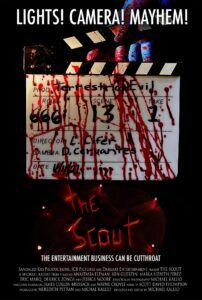 Click for the movie on Roku!
Click for the movie on Roku!The Scout is a good example and very “meta” in terms of how low/micro/no budget movies are in both a realistic way and a tongue-in-cheek way. We poked fun at the fact that if you were in the fictitious film being made within The Scout, you most likely would be working “ON” the film too. You’d be wearing a couple of hats aside from acting. The movie within the movie is also a micro-budget project, so every actor had a production role. Hell, The Scout was so “meta” our special make-up effects woman, McKenzie Kelly, played the make-up effects girl in the movie, was our effects person on the movie, and BECOMES the ultimate special effect IN the movie. I’ll let you see it to figure out what I mean, but, yeah… LOL… we made fun of and embraced our micro-budget, and it carried into the actual script and film of the trials and tribulations about making a micro-budget movie.
2. Hollywood Hive. The Scout begins with a character describing Hollywood as a “hive of scum and villainy.” Since the film is horror and centered around Hollywood filmmaking, I’m tempted to see some commentary, perhaps even a theme about Hollywood’s dark side. What is your film’s vision of Hollywood? Do you personally share that vision? Why or why not?

MK: Ah, yes… Carl Crew, as “The Producer.” I wrote that scene in the opening based on conversations I’ve had with Carl and others, and we’ve all heard the rumors/stories of the dark side of Hollywood… the satanic stuff… Hollywood is filled with pedophiles… the creepiness goes on and on. I’m sure there’s truth in these whisperings of Hollywood’s darkness. I’m not in that world. I wrote it as a catalyst for the motivation of a character more than any belief in the more realistic side of those tales of Tinsel Town’s corruption.
The “Hollywood” in The Scout is a broader, bigger creature that these small-time filmmakers only know from watching Entertainment Tonight. It’s a pipe dream that seems so far away and yet so close as they struggle to make their first movie. In a way, it’s the ultimate fantasy of “making it” that drives them. I wanted to highlight the almost impossible and unrealistic goal that fame is achievable once you make a movie. The filmmakers are a bit delusional, like a lot of filmmakers starting out… including myself back when I was younger and greener.
Not to say you shouldn’t dream big and reach for the stars. I’m STILL trying every day, but the “machine” that exists currently is a VERY hard nut to crack, and you have to be persistent… to the point of obsession, to reach even SOME of your dreams, let alone becoming an overnight success. That rarely happens, but I digress.
I think the vision of Hollywood in The Scout IS that ideal of “making it,” but the circumstances that keep them from their dreams are an over-the-top, satirical take on the question “what could possibly go wrong?” For them, it’s the worst of the worst.
Certainly, I have run into many obstacles in my career, what there is of it, that have hindered many things, and I have overcome them or changed trajectory. “Hollywood,” as it is now, is hard, and breaking in hasn’t gotten easier. It’s gotten simpler to make a movie seeing that you can literally make a movie on a high-end cellphone now, literally shoot and edit your movie on your phone. I started on Super-8, and once I made my first feature, went to 16mm film, and both got expensive quickly. So, creating is much easier, but having a studio or a production company drop a bunch of money in your lap is still the hard part.
I feel the pain of the young, bright-eyed dreamers who make up the rag-tag filmmakers/actors in The Scout. Trying to break into the business is and always has been difficult. It’s not for the weak or squeamish. Keep your head down and wear a helmet.
3. Talking Horror. After the introductory kill scene, The Scout focuses on the process of putting together the cast and crew for a low-budget slasher/sci-fi film. Another quick kill comes in halfway through, followed by a longer scene of characters discussing classic horror films. In some ways, then, the balance of The Scout tips more toward being a movie about horror movies than toward being a horror movie itself. Why did you structure so much of the film this way? I’m a horror nerd right there in the conversations with the characters, but how do more general audiences react to your movie’s focus on movies? What reactions would please you the most?
MK: Well, when I first received the script, I saw the beats and decided to try something I thought might work with the found footage style. You don’t technically have to adhere to a traditional three-act structure with “found footage.” You can use that to your advantage and potentially build suspense even if it’s not a typical way to write. It was a bit of an experiment with playing outside the box with structure and pacing.
Did it work? Not on everyone… LOL. I’ve gotten some reviews that aren’t in favor of what I did. Some say they HATED the sequence in the van that you speak of. They hated the van banter. Some hated the pre-production/audition sequence (which is the first third of the movie). I can understand that. I even think the opening is a bit too long. Looking back, I would have done a couple of things to break that up, but I was also on a schedule, so once I wrote a draft, which took a bit longer than I wanted, we started shooting.
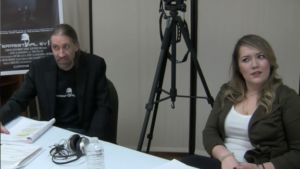
Some people really loved the movie in its entirety. My pal Bruce Campbell enjoyed the character development and for a minute got so into the characters he forgot it was a horror movie until things started going horribly wrong. Another pal, infamous character actor Danny Roebuck, loved the movie and was impressed with what I did for no money. Some audiences just didn’t like it while others did. AS they say, you can’t please everybody.
I just went into it wanting to make a fun, silly, spooky, exciting movie with a few jump scares… as much fun as I could put on screen for the cheapest budget I’ve ever had. It played/premiered at the historic Chinese Theatre in Hollywood (during Screamfest) and that audience really got into it, laughing at the right times and being creeped out at the right times, so it is what it is. I’m glad some people really liked it. I thought it was going to die down the board. I was surprised it was received so well. Of course, I was hoping everyone on the planet would love it, but that’s not how things work, I guess… LOL.
4. Cameras on Camera. Most, if not all, of The Scout consists of footage shot by cameras located within the world of the story—if not cameras wielded by characters, then security cameras or other cameras positioned in the locations where action takes place. Why did you take this approach, which you’ve already connected to “found footage” movies? How do you think it affects the viewing experience?
MK: Oh, The Scout is… a found footage movie [because] it was one of the requirements from the executive producer. It had to be found footage style. It’s a “find footage wherever you can to be able to create the movie” movie.
I’m not a HUGE found-footage film guy. I like some of them. I think it’s an interesting genre, and it’s absolutely great for low budgets, as The Blair Witch Project (amongst others) have shown us. The thing that bothers me about something like Cloverfield, while I personally enjoyed that movie: why would you keep filming? I wouldn’t. That camera would be lying on the ground the first moment a giant monster rolls the head of the Statue of Liberty near my apartment. So, I wanted to make a found footage movie that was plausible enough for the “found footage” to make complete sense… or at least sense in the confines of this particular world.
I also felt, since we all do have cameras and as a society take pictures and videos on the regular, that it would immerse the audience a bit more, pull them into this horror movie realm. It did create a challenge in the edit, and with multiple takes, there was a lot of footage shot… a lot of material to cut together. It took a bit longer to edit than originally expected because of all the footage I had to deal with from multiple cameras when it was all said and done.
5. Occult Horrors. The Scout mentions occult goings-on in Hollywood at least in passing, and Inner Demons engages the occult directly, dealing not only with creatures that seem to qualify as the beings in the title but also with questions about religious belief and about life after death. What draws you to occult matters in your films? Do you think Inner Demons has particular appeal for viewers with particular beliefs? Why or why not?
MK: With The Scout, the “occult” made a good motivation and twist (check out The Scout to see what I mean).
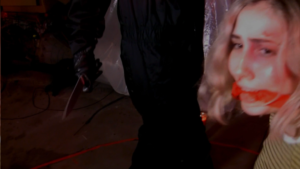
For Inner Demons, it IS the story. I was raised Catholic. I went to a co-ed Catholic school first through eighth grade and an all-male Catholic college prep school ninth through twelfth grade, so I’ve had the religious thing drilled into my head for a large portion of my life, and while I am a spiritual person, I have my own personal beliefs now as an adult.
I do appreciate the stories, fables, and parables related to religion, as a lot of them are thematically related to other more accessible, less religion-focused, more universal tales. I’ve been fascinated by religious allegories and their unreligious but related counterparts in literature and mythology, whether classic or contemporary. I believe in ghosts. I’ve had “supernatural” experiences. It’s intriguing to me, to explore that part of the unknown.
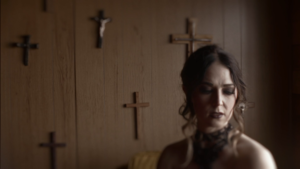
With Inner Demons, again, I wanted to make a fun, crazy, creepy horror film that would appeal to a wide audience while, at the same time, playing in the proverbial “occult” or supernatural” sandbox. I guess I’m particularly drawn to that kind of material because it’s what I know, and they say to write what you know. I just hope I made a widely accessible horror picture that stands the test of time, is re-watchable, and everyone who likes horror can enjoy.
6. Demon Editing. Inner Demons involves a fair bit of discontinuity editing, jumping around as the main character, Angela, flashes back and forth among different moments in time, memories, hallucinations, dreams, and visions. Why did you choose this structure? How does it enrich the story as well as the development of Angela’s character? Could you have told the story any other way? Why or why not?
MK: Another “experiment” really. I chose the structure to see if I could do it and to see if that kind of disjointed storytelling can work without spoon-feeding the audience like some movies do. I give the audience more of the benefit of the doubt than a lot of movies that tend to force-feed the viewers every ounce of information the filmmakers think they need. It’s not always necessary. The greats, like Hitchcock, rely on the visual and also let the spectators use their imaginations.
With Inner Demons, I wanted the audience to always be guessing what was happening and, every once in a while, throw them for a loop and take them in a different direction. It’s not traditional narrative editing. I’m a huge fan of that… of telling different stories different ways, interesting ways. I like when the viewer is compelled enough to enjoy participation in the film, guessing to see if their ideas of where the story is going are correct or if I fooled them enough to surprise them. A lot of people who saw Inner Demons left the theatre satisfied… they were enthralled and invested in the story and characters, and they were thrilled, excited, and shocked by the story and its final outcome.
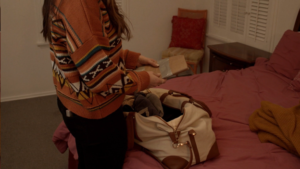
One thing about doing these micro-budget films for me is that I DO get to experiment and play with traditional story structure and rhythm. You usually can’t get away with that if you’re dealing with a studio or with large sums of money. It’s too risky for those types of folks, under most circumstances. Of course, a few can get away with it. I figure if I have the control to make something more creative, strange, and weird, I might as well try my hardest while I have that option.
I could have told Inner Demons in a more conventional manner, but it wasn’t meant to be… LOL. It came out that way very organically when I wrote it. I think the more “artistic” construction of the storyline helped the dream-like and psychedelic tone I was going for. I think the more… confused is the wrong word… but misleading editing style added to the confusion the Angela character is feeling as the story unfolds. It’s her we follow into her strange experiences. Let’s make the audience wonder and ask the same questions the character would wonder or ask… pull them into the film more than just observing.
7. Influential Demons. Your description of Inner Demons suggests Herk Harvey’s Carnival of Souls (1962), Adrian Lyne’s Jacob’s Ladder (1990), Sam Raimi’s Evil Dead (1981), and Sam Raimi’s Drag Me To Hell (2009) as influences. I may be off base, but some of Angela’s visions look like the Black Lodge in David Lynch’s Twin Peaks (1990-1991) and the Beyond in Lucio Fulci’s The Beyond (1981) to me, so I’d throw them in, too. Why are such influences so important to you? How does referring to them through story and/or visual elements affect Inner Demons and the ways people understand it?
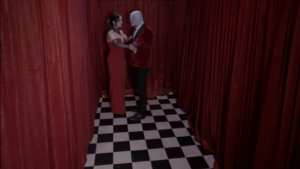 Lynch’s Black Lodge?
Lynch’s Black Lodge?MK: Lynch and Fulci, as well? I’ll take them both. To be honest, part of the reason I shot certain things for some of Angela’s visions were the locations I found (here we are back to locations). These were rentable locations I found on Peerspace.com and Giggster.com. Some of the locations I found, I wrote into the script simply because they were art directed and ready to film in, in turn, adding production value and making the movie look a bit bigger and more expensive. I also wanted to add a “familiarity” to some of the visions, call it paying homage or whatever. I dig Lynch and Fulci, too, so I take your comparisons as a compliment, for sure.
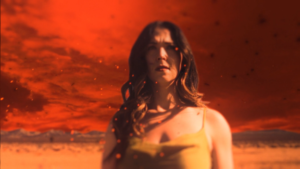 Fulci’s Beyond?
Fulci’s Beyond?I attempted to remake Carnival of Souls way back in the early to mid-nineties. I’ve always loved that movie and thought I could really ramp up the horror, dread and suspense without going gonzo crazy with the special effects. It’s creepy because of the less is more approach. Obviously, my remake never happened, but I always wanted to visit that concept of life after death, a lost soul trying to make sense of it all and that desperation of not knowing your place in the universe. Throw in a few more monsters and you got a scary movie with some thought behind it.
8. Hatred of a Minute Returns. In our correspondence, you mentioned that later in 2024, you’ll be re-releasing your first horror film, which Bruce Campbell produced, Hatred of a Minute. The film’s description on IMDb mentions the main character’s “physically and mentally abusive past” as well as the “war” he sees unfold “in the form of personal angels and demons,” so even though in this film the main character is a serial killer, it seems to have themes in common with Inner Demons. How do you reflect on abuse in this film, and how have your reflections on abuse changed in more recent work? What—other than the obvious commercial potential—inspires you to bring back Hatred of a Minute now?
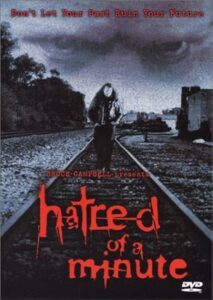 Click for the trailer!
Click for the trailer!MK: My pal Fox Valade saw the similarities in both films, companion pieces, so to speak. It was a revisit to that type of filmmaking. Hatred steers away from direct linear storytelling, too. It’s not as extreme as what I did with Inner Demons, but they are cut from the same untraditional narrative cloth.
Hatred’s abuse is the catalyst in the way that it’s more of a revenge film; at least it’s more focused on revenge. In Inner Demons abuse is more about being a victim, surviving and rising above the abuse (with a little bit of revenge thrown in). Both are similar thematically but different at the same time.
I find using abuse as a plot device works well. Surviving abuse, whether physical or emotional, is something that takes courage, strength and perseverance. It makes the hero tragic and relatable. Everyone has had to overcome something in life, something that’s been difficult, no matter what it is or was. I like watching the underdog crawl from the wreckage in movies, so I gravitate to those kinds of stories, whether I’m watching them or making them.
As for bringing Hatred of a Minute back now? I’m all about film restoration. I shot my first few features on film. I started making movies on film, so aside from wanting to re-release my first feature again in the hope it finds the next generation of viewers and fans (and the fact that Gunnar Hansen is in it, and he’s no longer with us), the preservation of film is very important to me. It’s also a fun movie, flawed but fun, creepy and atmospheric. It doesn’t hurt if I make a few bucks either, though it never did on the initial release… LOL!
The story of making the film is also important to me. I hope to inspire younger filmmakers to create, no matter how difficult or discouraging this business can be. The new extras will go through the making of the film and the obstacles we smashed though.
9. Dinner with Destiny. Your history with Gunnar Hansen, the actor who played Leatherface in the original Texas Chain Saw Massacre (1974), has inspired you to make the documentary about him Dinner with Leatherface. Who’s going to enjoy seeing a feature-length tribute to an actor mostly known for playing a single (but truly iconic) character? Should Robert Englund and Kane Hodder be in someone’s queue for feature adoration, or would you argue that Hansen stands a cut above? Why or why not?
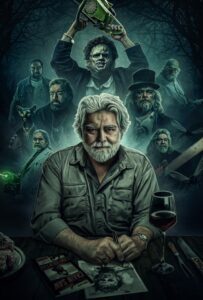 Click for a rough trailer for Dinner with Leatherface–both a new trailer and the film are coming soon!
Click for a rough trailer for Dinner with Leatherface–both a new trailer and the film are coming soon!MK: Robert Englund and Kane Hodder both have their own feature length documentaries already (I thought of mine before theirs were ever produced). [Oops! – LAC]
When Gunnar was alive, I joked about making a doc about him, as he was such a worldly, intelligent and interesting person. Aside from being a published writer, he was a poet, documentarian, writer, and producer, a computer whiz, a whiskey lover, a sailor, a crab fisherman AND an actor… when he felt like it.
He kept his private life very private and his “industry” life the way he wanted it… on HIS own terms. He would have probably said the same thing if he was still with us: “Why make a documentary about a guy who played Leatherface once?” He was way more than that. He did SEVERAL indie movies in Michigan in the late 70’s that made him say he’d never act again.
Once he started doing the convention circuit in the mid-eighties, meeting fans and signing pictures and the like, he was sucked back in. He agreed to do my first feature as he was finishing up another Michigan-based production, Gary Jones’ Mosquito. I ended up poaching four or five actors from Mosquito for Hatred of a Minute.
Fans adored Gunnar. His friends and colleagues loved him, and he led a pretty interesting and amazing life outside of doing B-movies in the Midwest. Top it all off with being in one of the most infamous horror movies ever, and that intrigued me. If there were a Mount Rushmore of modern horror icons, it would be Jason, Freddy, Michael Myers, and Leatherface carved in that mountain.
Horror fans will enjoy the doc about an icon who embraced and revered his fans. I think people who aren’t horror fans will enjoy the film as well… seeing a pretty laid-back, well-spoken, funny intellectual who had many talents and life experiences… a man who played one of the most recognizable film villains known around the world… and what other accomplishments he made and how he didn’t need to be in the movie business. He did it on his terms, like he did everything. That’s compelling.
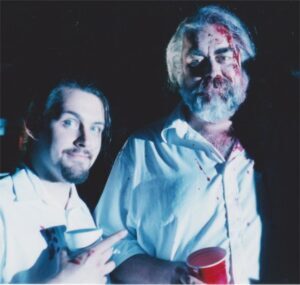 Kallio with Hansen
Kallio with HansenHe was also a friend who championed me and my career back when I was first starting out. He deserves the love letter that this documentary will be.
10. Access! How can people learn more about you, view your films, purchase your films, and generally get access to your world (please provide any links you want to share)?
MK: My socials: www.facebook.com/filmmike, www.instagram.com/michael.kallio
For shorts, music videos, trailers, and more: www.youtube.com/darkallio, www.vimeo.com/michaelkallio
Websites in progress: www.michaelkalliofilms.com, www.modernclassicpictures.com (my production company)
The Scout is on Tubi, Roku, Google Play and DVD, (with behind-the-scenes, commentary by cast and crew and Q&A from Screamfest 2021)
Trailer:
Mutant Swinger from Mars (a 1950s sci-fi/horror spoof) is on Tubi and Amazon and will also be released on Blu-ray in a special edition in 2024.
Trailer:
Also check out these pages for my upcoming production Rednecks vs. Aliens!
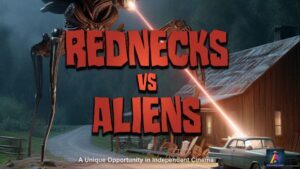 Click for Instagram
Click for InstagramOr Facebook: https://www.facebook.com/rednecksvsaliens
About the FilmmakerClick for IMDb info!Born at an early age in Detroit, Michigan, Michael started making Super-8 movies at 6 years old after seeing Star Wars. In his early 20’s, he made his first feature film, Hatred of a Minute, a psychological thriller starring himself and and produced by . A second feature followed, Mutant Swinger from Mars, a 50’s sci-fi spoof inspired by Ed Wood and the Jerry Lewis film The Nutty Professor, which featured the acting debut of The White Stripes front man and guitarist Jack White. He has had his hand in every aspect of the film industry, working not only as a writer, director, producer, actor, and editor but also a special effects artist, a production designer, and an art director. He is currently doing two documentaries. One is on his late friend and colleague Gunnar Hansen, Dinner with Leatherface. The other focuses on the local Southern California band The Radioactive Chicken Heads and is tentatively titled Cluckumentary. Recently he directed back-to-back-to-back features, the found-footage/slasher film The Scout, another atmospheric horror film, Inner Demons, and An LA Christmas Story, a Christmas rom-com on which he is wrapping up post-production. Sometimes, he writes stuff, too. He has an essay about the film Evil Dead 2 in Volume 3 of My Favorite Horror Movie: Scream Warriors and writes weird poetry. He is also currently working on a sci-fi/horror/comedy entitled Rednecks Vs. Aliens, among other film and television projects. He hangs out with his wife, Jessica, and their fur baby/dog, Buddy.
The post Interview with Filmmaker Michael Kallio: The Scout, Inner Demons, and More appeared first on L. Andrew Cooper's Horrific Scribblings.



